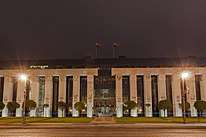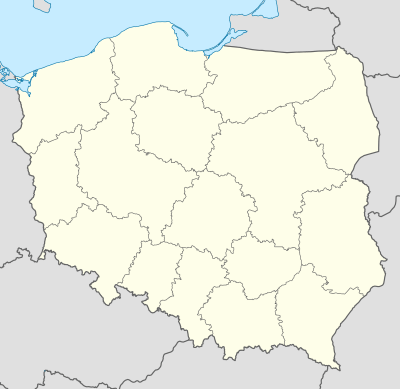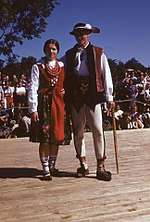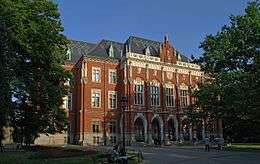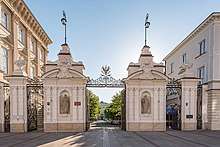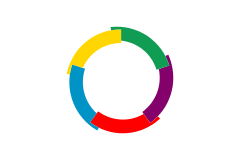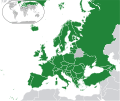Poland
Poland (Polish: Polska [ˈpɔlska] (![]()
![]()
Republic of Poland | |
|---|---|
Anthem: "Mazurek Dąbrowskiego" (English: "Poland Is Not Yet Lost") | |
.svg.png)  Location of Poland (dark green) – in Europe (green & dark grey) | |
| Capital and largest city | Warsaw 52°13′N 21°02′E |
| Official languages | Polish[1] |
| Recognised regional language | Kashubian |
| Ethnic groups | |
| Religion (2015[5]) |
|
| Demonym(s) |
|
| Government | Unitary semi-presidential constitutional republic |
| Andrzej Duda | |
| Mateusz Morawiecki | |
| Legislature | Parliament |
| Senate | |
| Sejm | |
| Formation | |
| 14 April 966 | |
| 18 April 1025 | |
• Polish-Lithuanian Commonwealth | 1 July 1569 |
| 24 October 1795 | |
| 22 July 1807 | |
| 9 June 1815 | |
| 11 November 1918 | |
| 17 September 1939 | |
| 19 February 1947 | |
| 13 September 1989 | |
| Area | |
• Total | 312,696[7] km2 (120,733 sq mi)[lower-alpha 2] (69th) |
• Water (%) | 3.07 |
| Population | |
• 2019 estimate | |
• Density | 123/km2 (318.6/sq mi) (83rd) |
| GDP (PPP) | 2020 estimate |
• Total | |
• Per capita | |
| GDP (nominal) | 2020 estimate |
• Total | |
• Per capita | |
| Gini (2019) | low |
| HDI (2018) | very high · 32nd |
| Currency | Polish złoty (PLN) |
| Time zone | UTC+1 (CET) |
| UTC+2 (CEST) | |
| Driving side | right |
| Calling code | +48 |
| ISO 3166 code | PL |
| Internet TLD | .pl |
Website poland.pl | |
Poland is bordered by the Baltic Sea, Lithuania, and Russia's Kaliningrad Oblast to the north, Belarus and Ukraine to the east, Slovakia and the Czech Republic to the south, and Germany to the west.
The history of human activity on Polish soil spans thousands of years. Throughout late antiquity it became extensively diverse, with various cultures and tribes settling on the vast Central European Plain. However, it was the Western Polans who dominated the region and gave Poland its name. The establishment of Polish statehood can be traced to 966, when the pagan ruler of a realm coextensive with the territory of present-day Poland embraced Christianity and converted to Catholicism.[14] The Kingdom of Poland was founded in 1025, and in 1569 it cemented its longstanding political association with Lithuania by signing the Union of Lublin. This union formed the Polish–Lithuanian Commonwealth, one of the largest (over 1,000,000 square kilometres – 400,000 square miles) and most populous nations of 16th and 17th century Europe, with a uniquely liberal political system which adopted Europe's first written national constitution, the Constitution of 3 May 1791.[15][16]
With the passing of prominence and prosperity, the country was partitioned by neighbouring states at the end of the 18th century, and regained independence in 1918 with the Treaty of Versailles. After a series of territorial conflicts, the new multi-ethnic Poland restored its position as a key player in European politics. In September 1939, World War II began with the invasion of Poland by Nazi Germany, followed by the Soviet Union invading Poland in accordance with the Molotov–Ribbentrop Pact. Approximately six million Polish citizens, including three million of the country's Jews, perished during the course of the war.[17][18] As member of the Eastern Bloc, the Polish People's Republic proclaimed forthwith was a chief signatory of the Warsaw Treaty amidst global Cold War tensions. In the wake of the 1989 events, notably through the emergence and contributions of the Solidarity movement, the communist government was dissolved and Poland reestablished itself as a presidential democratic republic.
Poland has a developed market and is a regional power in Central Europe, with the largest stock exchange in the East-Central European zone.[19] It has the sixth largest economy by GDP (nominal) in the European Union[20] and the tenth largest in all of Europe. It's one of the most dynamic economies in the world,[21] simultaneously achieving a very high rank on the Human Development Index.[22] Poland is a developed country,[23][24] which maintains a high-income economy[25] along with very high standards of living, life quality,[26] safety, education, and economic freedom.[27][28] Alongside a developed educational system, the state also provides free university education, social security, and a universal health care system.[29][30] The country has 16 UNESCO World Heritage Sites, 15 of which are cultural.[31]
Poland is a member state of the Schengen Area, the United Nations, NATO, the OECD, the Three Seas Initiative, the Visegrád Group, and guested at the G20.
Etymology
The origin of the name "Poland" derives from the Lechitic tribe of Polans (Polanie), who inhabited the Warta river basin of present-day Greater Poland region starting in the mid-6th century. The origin of the name Polanie itself derives from the Proto-Slavic word pole (field). In some languages, such as Hungarian, Lithuanian, Persian and Turkish, the country's name is derived from the Lendians (Lędzianie or Lachy),[32] who dwelled on the southeasternmost edge of present-day Lesser Poland, in the Cherven Grods between the 7th and 11th centuries — lands which were part of the territorial domain ruled over by the Polans. Their name derives from the Old Polish word lęda (open land or plain).[33]
History
Prehistory and protohistory
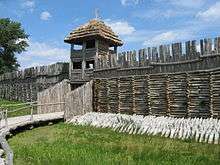
The early Bronze Age in Poland began around 2400 BC, while the Iron Age commenced in approximately 700 BC.[34] During this time, the Lusatian culture, spanning both the Bronze and Iron Ages, became particularly prominent. The most famous archaeological find from the prehistory and protohistory of Poland is the Biskupin fortified settlement (now reconstructed as an open-air museum), dating from the Lusatian culture of the late Bronze Age, around 748 BC.[35][36]
Throughout the Antiquity period, many distinct ancient ethnic groups populated the regions of what is now Poland in an era that dates from about 400 BC to 500 AD. These groups are identified as Celtic, Scythian, Germanic, Sarmatian, Slavic and Baltic tribes. Also, recent archeological findings in the Kuyavia region, confirmed the presence of the Roman Legions on the territory of Poland.[37] These were most likely expeditionary missions sent out to protect the amber trade. The exact time and routes of the original migration and settlement of Slavic peoples lacks written records and can only be defined as fragmented.[38] The West Slavic or Lechitic tribes who initially inhabited Poland migrated to these areas in the second half of the 5th century AD. Up until the creation of Mieszko's state and his subsequent conversion to Christianity in 966 AD, the main religion of the numerous tribes that inhabited the geographical area of present-day Poland was paganism. With the Baptism of Poland the Polish rulers accepted Western Christianity and the religious authority of the Roman Church. However, the transition from paganism was not a smooth and instantaneous process for the rest of the population as evident from the pagan reaction of the 1030s.[39]
Piast dynasty
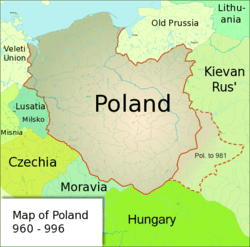
Poland began to form into a recognizable unitary and territorial entity around the middle of the 10th century under the Piast dynasty. Poland's first historically documented ruler, Mieszko I, accepted Christianity, as the rightful religion of his realm, under the auspices of the Latin Church with the Baptism of Poland in 966. The bulk of the population converted in the course of the next few centuries. In 1000, Boleslaw the Brave, continuing the policy of his father Mieszko, held a Congress of Gniezno and created the metropolis of Gniezno and the dioceses of Kraków, Kołobrzeg, and Wrocław. However, the pagan unrest led to the transfer of the capital to Kraków in 1038 by Casimir I the Restorer.[40]
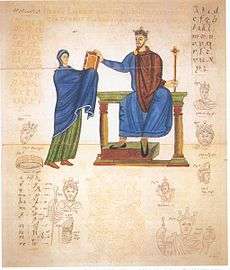
In 1109, Prince Bolesław III Wrymouth defeated the King of Germany Henry V at the Battle of Hundsfeld, stopping the German incursion into Poland. The clash between Bolesław III and Henry V was documented by Gallus Anonymus in his 1118 chronicle.[41] In 1138, Poland fragmented into several smaller duchies when Bolesław divided his lands among his sons. In 1226, Konrad I of Masovia, one of the regional Piast dukes, invited the Teutonic Knights to help him fight the Baltic Prussian pagans; a decision that led to centuries of warfare with the Knights. In 1264, the Statute of Kalisz or the General Charter of Jewish Liberties introduced numerous right for the Jews in Poland, leading to a nearly autonomous "nation within a nation".[42]
In the middle of the 13th century, the Silesian branch of the Piast dynasty (Henry I the Bearded and Henry II the Pious, ruled 1238–1241) nearly succeeded in uniting the Polish lands, but the Mongols invaded the country from the east and defeated the combined Polish forces at the Battle of Legnica where Duke Henry II the Pious died. In 1320, after a number of earlier unsuccessful attempts by regional rulers at uniting the Polish dukedoms, Władysław I consolidated his power, took the throne and became the first king of a reunified Poland. His son, Casimir III (reigned 1333–1370), has a reputation as one of the greatest Polish kings, and gained wide recognition for improving the country's infrastructure.[43][44] He also extended royal protection to Jews, and encouraged their immigration to Poland.[43][45] Casimir III realized that the nation needed a class of educated people, especially lawyers, who could codify the country's laws and administer the courts and offices. His efforts to create an institution of higher learning in Poland were finally rewarded when Pope Urban V granted him permission to open the University of Kraków.
The Golden Liberty of the nobles began to develop under Casimir's rule, when in return for their military support, the king made a series of concessions to the nobility, and establishing their legal status as superior to that of the townsmen. When Casimir the Great died in 1370, leaving no legitimate male heir, the Piast dynasty came to an end.
During the 13th and 14th centuries, Poland became a destination for German, Flemish and to a lesser extent Walloon, Danish and Scottish migrants. Also, Jews and Armenians began to settle and flourish in Poland during this era (see History of the Jews in Poland and Armenians in Poland).
The Black Death, a plague that ravaged Europe from 1347 to 1351, did not significantly affect Poland, and the country was spared from a major outbreak of the disease.[46][47] The reason for this was the decision of Casimir the Great to quarantine the nation's borders.
Jagiellon dynasty
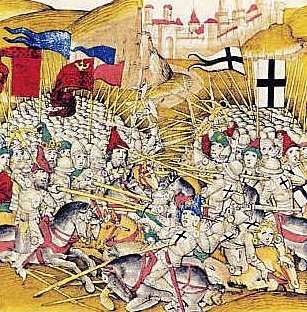
The Jagiellon dynasty spanned the late Middle Ages and early Modern Era of Polish history. Beginning with the Lithuanian Grand Duke Jogaila (Władysław II Jagiełło), the Jagiellon dynasty (1386–1572) formed the Polish–Lithuanian union. The partnership brought vast Lithuanian-controlled Rus' areas into Poland's sphere of influence and proved beneficial for the Poles and Lithuanians, who coexisted and cooperated in one of the largest political entities in Europe for the next four centuries.
In the Baltic Sea region the struggle of Poland and Lithuania with the Teutonic Knights continued and culminated at the Battle of Grunwald in 1410, where a combined Polish-Lithuanian army inflicted a decisive victory against them.[48] In 1466, after the Thirteen Years' War, King Casimir IV Jagiellon gave royal consent to the Peace of Thorn, which created the future Duchy of Prussia under Polish suzerainty. The Jagiellon dynasty at one point also established dynastic control over the kingdoms of Bohemia (1471 onwards) and Hungary.[49][50] In the south, Poland confronted the Ottoman Empire and the Crimean Tatars (by whom they were attacked on 75 separate occasions between 1474 and 1569),[51] and in the east helped Lithuania fight the Grand Duchy of Moscow. Some historians estimate that Crimean Tatar slave-raiding cost Poland-Lithuania one million of its population between the years of 1494 and 1694.[52]
.jpg)
Poland was developing as a feudal state, with a predominantly agricultural economy and an increasingly powerful landed nobility. The Nihil novi act adopted by the Polish Sejm (parliament) in 1505, transferred most of the legislative power from the monarch to the Sejm, an event which marked the beginning of the period known as "Golden Liberty", when the state was ruled by the "free and equal" Polish nobility. Protestant Reformation movements made deep inroads into Polish Christianity, which resulted in the establishment of policies promoting religious tolerance, unique in Europe at that time.[53] This tolerance allowed the country to avoid most of the religious turmoil that spread over Europe during the 16th century.[53]
The European Renaissance evoked in late Jagiellon Poland (under kings Sigismund I the Old and Sigismund II Augustus) a sense of urgency in the need to promote a cultural awakening, and during this period Polish culture and the nation's economy flourished. In 1543, Nicolaus Copernicus, an astronomer from Toruń, published his epochal work De revolutionibus orbium coelestium (On the Revolutions of the Celestial Spheres), and thereby became the first proponent of a predictive mathematical model confirming the heliocentric theory, which became the accepted basic model for the practice of modern astronomy. Another major figure associated with the era is the classicist poet Jan Kochanowski.[54]
Polish–Lithuanian Commonwealth
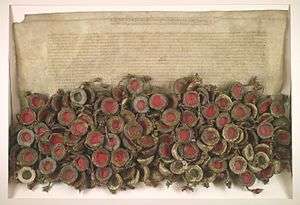
The 1569 Union of Lublin established the Polish–Lithuanian Commonwealth, a more closely unified federal state with an elective monarchy, but which was governed largely by the nobility, through a system of local assemblies with a central parliament. The Warsaw Confederation (1573) guaranteed religious freedom for the Polish nobility (szlachta) and townsfolk (mieszczanie). However, the peasants (chłopi) were still subject to severe limitations imposed on them by the nobility.[42] The establishment of the Commonwealth coincided with a period of stability and prosperity in Poland, with the union thereafter becoming a European power and a major cultural entity, occupying approximately one million square kilometers of Central and Eastern Europe, as well as an agent for the dissemination of Western culture through Polonization into areas of modern-day Lithuania, Latvia, Ukraine, Belarus and western Russia.
In the 16th and 17th centuries, Poland suffered from a number of dynastic crises during the reigns of the Vasa kings Sigismund III and Władysław IV and found itself engaged in major conflicts with Russia, Sweden and the Ottoman Empire, as well as a series of minor Cossack uprisings.[55] In 1610, a Polish army under the command of Hetman Stanisław Żółkiewski seized Moscow after winning the Battle of Klushino. In 1611, the Tsar of Russia paid homage to the King of Poland.
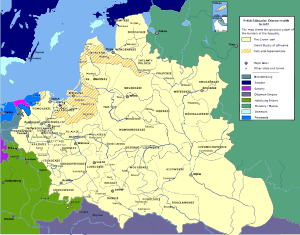
After the signing of Truce of Deulino, Poland had in the years 1618–1621 an area of about 1 million km2 (390,000 sq mi).
From the middle of the 17th century, the nobles' democracy, suffering from internal disorder, gradually declined, thereby leaving the once powerful Commonwealth vulnerable to foreign intervention. Starting in 1648, the Cossack Khmelnytsky Uprising engulfed the south and east, eventually leaving Ukraine divided, with the eastern part, lost by the Commonwealth, becoming a dependency of the Tsardom of Russia. This was followed by the 'Deluge', a Swedish invasion of Poland, which marched through the Polish heartlands and ruined the country's population, culture and infrastructure—around four million of Poland's eleven million inhabitants died in famines and epidemics throughout the 17th century.[56] However, under John III Sobieski the Commonwealth's military prowess was re-established, and in 1683 Polish forces played a major role in the Battle of Vienna against the Ottoman Army, commanded by Kara Mustafa, the Grand Vizier of the Ottoman Empire.
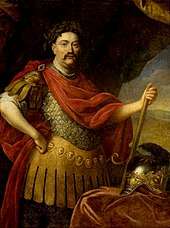
Sobieski's reign marked the end of the nation's golden era. Finding itself subjected to almost constant warfare and suffering enormous population losses as well as massive damage to its economy, the Commonwealth fell into decline. The government became ineffective as a result of large-scale internal conflicts (e.g. Lubomirski Rebellion against John II Casimir and rebellious confederations) and corrupted legislative processes. The nobility fell under the control of a handful of magnats, and this, compounded with two relatively weak kings of the Saxon Wettin dynasty, Augustus II and Augustus III, as well as the rise of Russia and Prussia after the Great Northern War only served to worsen the Commonwealth's plight. Despite this The Commonwealth-Saxony personal union gave rise to the emergence of the Commonwealth's first reform movement, and laid the foundations for the Polish Enlightenment.[57]
During the later part of the 18th century, the Commonwealth made attempts to implement fundamental internal reforms; with the second half of the century bringing a much improved economy, significant population growth and far-reaching progress in the areas of education, intellectual life, art, and especially toward the end of the period, evolution of the social and political system. The most populous capital city of Warsaw replaced Gdańsk (Danzig) as the leading centre of commerce, and the role of the more prosperous townsmen increased.
Partitions
The royal election of 1764 resulted in the elevation of Stanisław II August (a Polish aristocrat connected to the Czartoryski family faction of magnates) to the monarchy. However, as a one-time personal admirer of Empress Catherine II of Russia, the new king spent much of his reign torn between his desire to implement reforms necessary to save his nation, and his perceived necessity to remain in a political relationship with his Russian sponsor. This led to the formation of the 1768 Bar Confederation, a szlachta rebellion directed against the Polish king and his Russian sponsors, which aimed to preserve Poland's independence and the szlachta's traditional privileges. Attempts at reform provoked the union's neighbours, and in 1772 the First Partition of the Commonwealth by Prussia, Russia and Austria took place; an act which the "Partition Sejm", under considerable duress, eventually "ratified" fait accompli.[58] Disregarding this loss, in 1773 the king established the Commission of National Education, the first government education authority in Europe. Corporal punishment of children was officially prohibited in 1783.
The Great Sejm convened by Stanisław II August in 1788 successfully adopted the 3 May Constitution, the first set of modern supreme national laws in Europe. However, this document, accused by detractors of harbouring revolutionary sympathies, generated strong opposition from the Commonwealth's nobles and conservatives as well as from Catherine II, who, determined to prevent the rebirth of a strong Commonwealth set about planning the final dismemberment of the Polish-Lithuanian state. Russia was aided in achieving its goal when the Targowica Confederation, an organisation of Polish nobles, appealed to the Empress for help. In May 1792, Russian forces crossed the Commonwealth's frontier, thus beginning the Polish-Russian War.
The defensive war fought by the Poles ended prematurely when the King, convinced of the futility of resistance, capitulated and joined the Targowica Confederation. The Confederation then took over the government. Russia and Prussia, fearing the mere existence of a Polish state, arranged for, and in 1793 executed, the Second Partition of the Commonwealth, which left the country deprived of so much territory that it was practically incapable of independent existence. Eventually, in 1795, following the failed Kościuszko Uprising, the Commonwealth was partitioned one last time by all three of its more powerful neighbours, and with this, effectively ceased to exist.[59]
Era of insurrections
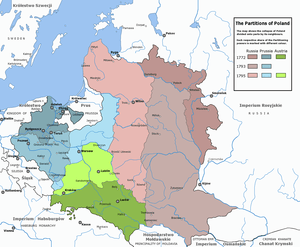
Poles rebelled several times against the partitioners, particularly near the end of the 18th century and the beginning of the 19th century. An unsuccessful attempt at defending Poland's sovereignty took place in 1794 during the Kościuszko Uprising, where a popular and distinguished general Tadeusz Kościuszko, who had several years earlier served under Washington in the American Revolutionary War, led Polish insurrectionists against numerically superior Russian forces. Despite the victory at the Battle of Racławice, his ultimate defeat ended Poland's independent existence for 123 years.[60]
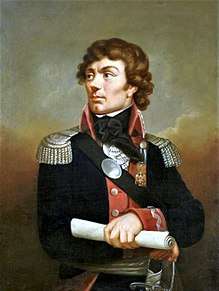
In 1807, Napoleon I of France temporarily recreated a Polish state as the satellite Duchy of Warsaw, after a successful Greater Poland Uprising of 1806 against Prussian rule. But, after the failed Napoleonic Wars, Poland was again split between the victorious powers at the Congress of Vienna of 1815.[62] The eastern part was ruled by the Russian tsar as Congress Poland, which had a liberal constitution. However, over time the Russian monarch reduced Polish freedoms, and Russia annexed the country in virtually all but name. Meanwhile, the Prussian controlled territory of Poland came under increased Germanization. Thus, in the 19th century, only Austrian-ruled Galicia, and particularly the Free City of Kraków, allowed free Polish culture to flourish.
Throughout the period of the partitions, political and cultural repression of the Polish nation led to the organisation of a number of uprisings against the authorities of the occupying Russian, Prussian and Austrian governments. In 1830, the November Uprising began in Warsaw when, led by Lieutenant Piotr Wysocki, young non-commissioned officers at the Officer Cadet School in Warsaw revolted. They were joined by large segments of Polish society, and together forced Warsaw's Russian garrison to withdraw north of the city.
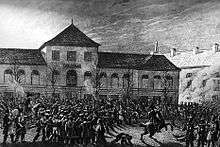
Over the course of the next seven months, Polish forces successfully defeated the Russian armies of Field Marshal Hans Karl von Diebitsch and a number of other Russian commanders; however, finding themselves in a position unsupported by any other foreign powers, save distant France and the newborn United States, and with Prussia and Austria refusing to allow the import of military supplies through their territories, the Poles accepted that the uprising was doomed to failure. Upon the surrender of Warsaw to General Ivan Paskievich, many Polish troops, feeling they could not go on, withdrew into Prussia and there laid down their arms. After the defeat, the semi-independent Congress Poland lost its constitution, army and legislative assembly, and was integrated more closely with the Russian Empire.[63]
During the Spring of Nations (a series of revolutions which swept across Europe), Poles took up arms in the Greater Poland Uprising of 1848 to resist Prussian rule. Initially, the uprising manifested itself in the form of civil disobedience, but eventually turned into an armed struggle when the Prussian military was sent in to pacify the region. Eventually, after several battles the uprising was suppressed by the Prussians, and the Grand Duchy of Posen was more completely incorporated into Prussia.[64]
In 1863, a new Polish uprising against Russian rule began. The January Uprising started out as a spontaneous protest by young Poles against conscription into the Imperial Russian Army. However, the insurrectionists, despite being joined by high-ranking Polish-Lithuanian officers and numerous politicians, were still severely outnumbered and lacking in foreign support. They were forced to resort to guerrilla warfare tactics and failed to win any major military victories. Afterwards no major uprising was witnessed in the Russian-controlled Congress Poland, and Poles resorted instead to fostering economic and cultural self-improvement. Congress Poland was rapidly industrialised towards the end of the 19th century, and successively transformed into the Empire's wealthiest and most developed subject.[65][66]
Despite the political unrest experienced during the partitions, Poland did benefit from large-scale industrialisation and modernisation programs, instituted by the occupying powers, which helped it develop into a more economically coherent and viable entity. This was particularly true in Greater Poland, Silesia and Eastern Pomerania controlled by Prussia (later becoming a part of the German Empire); areas which eventually, thanks largely to the Greater Poland Uprising of 1918 and Silesian Uprisings, were reconstituted as a part of the Second Polish Republic, becoming the country's most prosperous regions.[67]
Second Polish Republic
.jpg)
During World War I, all the Allies agreed on the reconstitution of Poland that United States President Woodrow Wilson proclaimed in Point 13 of his Fourteen Points. A total of 2 million Polish troops fought with the armies of the three occupying powers, and 450,000 died. Shortly after the armistice with Germany in November 1918, Poland regained its independence as the Second Polish Republic (II Rzeczpospolita Polska). It reaffirmed its independence after a series of military conflicts, the most notable being the Polish–Soviet War (1919–21) when Poland inflicted a crushing defeat on the Red Army at the Battle of Warsaw, an event which is considered to have halted the advance of Communism into Europe and forced Vladimir Lenin to rethink his objective of achieving global socialism. The event is often referred to as the "Miracle at the Vistula".[68]
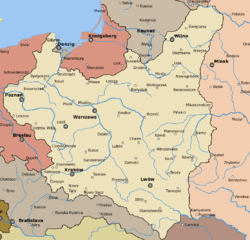
During this period, Poland successfully managed to fuse the territories of the three former partitioning powers into a cohesive nation state. Railways were restructured to direct traffic towards Warsaw instead of the former imperial capitals, a new network of national roads was gradually built up and a major seaport was opened on the Baltic Coast, so as to allow Polish exports and imports to bypass the politically charged Free City of Danzig.
The inter-war period heralded in a new era of Polish politics. Whilst Polish political activists had faced heavy censorship in the decades up until the First World War, the country now found itself trying to establish a new political tradition. For this reason, many exiled Polish activists, such as Ignacy Paderewski (who would later become prime minister) returned home to help; a significant number of them then went on to take key positions in the newly formed political and governmental structures. Tragedy struck in 1922 when Gabriel Narutowicz, inaugural holder of the presidency, was assassinated at the Zachęta Gallery in Warsaw by painter and right-wing nationalist Eligiusz Niewiadomski.[69]
In 1926, a May coup, led by the hero of the Polish independence campaign Marshal Józef Piłsudski, turned rule of the Second Polish Republic over to the nonpartisan Sanacja (Healing) movement in an effort to prevent radical political organizations on both the left and the right from destabilizing the country.[lower-alpha 4] The movement functioned integrally until Piłsudski's death in 1935. Following Marshall Piłsudski's death, Sanation split into several competing factions.[73] By the late 1930s, due to increased threats posed by political extremism inside the country, the Polish government became increasingly heavy-handed, banning a number of radical organizations, including communist and ultra-nationalist political parties, which threatened the stability of the country.[74]
As a subsequent result of the Munich Agreement in 1938, Czechoslovakia ceded to Poland the small 350 sq mi Zaolzie region. The area was a point of contention between the Polish and Czechoslovak governments in the past and the two countries fought a brief seven-day war over it in 1919.[75]
World War II

World War II began with the Nazi German invasion of Poland on 1 September 1939, followed by the Soviet invasion of Poland on 17 September. On 28 September 1939, Warsaw fell. As agreed in the Molotov–Ribbentrop Pact, Poland was split into two zones, one occupied by Nazi Germany, the other by the Soviet Union. In 1939–41, the Soviets deported hundreds of thousands of Poles. The Soviet NKVD executed thousands of Polish prisoners of war (inter alia Katyn massacre) ahead of the Operation Barbarossa.[76] German planners had in November 1939 called for "the complete destruction" of all Poles and their fate, as well as many other Slavs, as outlined in the genocidal Generalplan Ost.[77]
Polish intelligence operatives proved extremely valuable to the Allies, providing much of the intelligence from Europe and beyond,[78] and Polish code breakers were responsible for cracking the Enigma cipher.[lower-alpha 5]
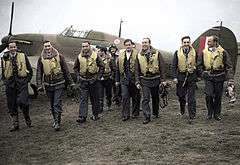
Poland made the fourth-largest troop contribution in Europe[lower-alpha 6] and its troops served both the Polish Government in Exile in the west and Soviet leadership in the east. Polish troops played an important role in the Normandy, Italian and North African Campaigns and are particularly remembered for the Battle of Monte Cassino.[83][84] In the east, the Soviet-backed Polish 1st Army distinguished itself in the battles for Warsaw and Berlin.[85]
During the Battle of Britain Polish squadrons such as the No. 303 "Kościuszko" fighter squadron achieved considerable success.[86]
The wartime resistance movement, and the Armia Krajowa (Home Army), fought against German occupation. It was one of the three largest resistance movements of the entire war,[lower-alpha 7] and encompassed a range of clandestine activities, which functioned as an underground state complete with degree-awarding universities and a court system.[93] The resistance was loyal to the exiled government and generally resented the idea of a communist Poland; for this reason, in the summer of 1944 it initiated Operation Tempest, of which the Warsaw Uprising that begun on 1 August 1944 is the best known operation.[85][94]
Nazi German forces under orders from Adolf Hitler set up six German extermination camps in occupied Poland, including Treblinka, Majdanek and Auschwitz. The Germans transported millions of Jews from across occupied Europe to be murdered in those camps.[95][96]
Altogether, 3 million Polish Jews[97][98] – approximately 90% of Poland's pre-war Jewry – and between 1.8 and 2.8 million ethnic Poles[99][100][101] were killed during the German occupation of Poland, including between 50,000 and 100,000 members of the Polish intelligentsia – academics, doctors, lawyers, nobility and priesthood.[102][103] Around 150,000 Polish civilians were killed by Soviets between 1939 and 1941 during the Soviet Union's occupation of eastern Poland (Kresy), and another estimated 100,000 Poles were murdered by the Ukrainian Insurgent Army (UPA) between 1943 and 1944 in what became known as the Wołyń Massacres.[104][105] Of all the countries in the war, Poland lost the highest percentage of its citizens: around 6 million perished – more than one-sixth of Poland's pre-war population – half of them Polish Jews.[18][106][107] About 90% of deaths were non-military in nature.[108]
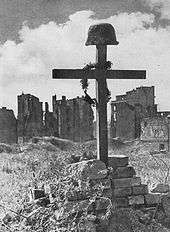
In 1945, Poland's borders were shifted westwards. Over two million Polish inhabitants of Kresy were expelled along the Curzon Line by Stalin.[109] The western border became the Oder-Neisse line. As a result, Poland's territory was reduced by 20%, or 77,500 square kilometres (29,900 sq mi). The shift forced the migration of millions of other people, most of whom were Poles, Germans, Ukrainians, and Jews.[110][111][112]
Post-war communism
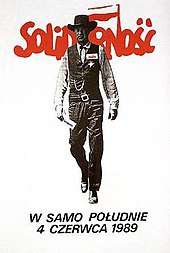
At the insistence of Joseph Stalin, the Yalta Conference sanctioned the formation of a new provisional pro-Communist coalition government in Moscow, which ignored the Polish government-in-exile based in London. This action angered many Poles who considered it a betrayal by the Allies. In 1944, Stalin had made guarantees to Churchill and Roosevelt that he would maintain Poland's sovereignty and allow democratic elections to take place. However, upon achieving victory in 1945, the elections organized by the occupying Soviet authorities were falsified and were used to provide a veneer of legitimacy for Soviet hegemony over Polish affairs. The Soviet Union instituted a new communist government in Poland, analogous to much of the rest of the Eastern Bloc. As elsewhere in Communist Europe, the Soviet influence over Poland was met with armed resistance from the outset which continued into the 1950s.
Despite widespread objections, the new Polish government accepted the Soviet annexation of the pre-war eastern regions of Poland[113] (in particular the cities of Wilno and Lwów) and agreed to the permanent garrisoning of Red Army units on Poland's territory. Military alignment within the Warsaw Pact throughout the Cold War came about as a direct result of this change in Poland's political culture. In the European scene, it came to characterize the full-fledged integration of Poland into the brotherhood of communist nations.
The new communist government took control with the adoption of the Small Constitution on 19 February 1947. The Polish People's Republic (Polska Rzeczpospolita Ludowa) was officially proclaimed in 1952. In 1956, after the death of Bolesław Bierut, the régime of Władysław Gomułka became temporarily more liberal, freeing many people from prison and expanding some personal freedoms. Collectivization in the Polish People's Republic failed. A similar situation repeated itself in the 1970s under Edward Gierek, but most of the time persecution of anti-communist opposition groups persisted. Despite this, Poland was at the time considered to be one of the least oppressive states of the Eastern Bloc.[114]
Labour turmoil in 1980 led to the formation of the independent trade union "Solidarity" ("Solidarność"), which over time became a political force. Despite persecution and imposition of martial law in 1981, it eroded the dominance of the Polish United Workers' Party and by 1989 had triumphed in Poland's first partially free and democratic parliamentary elections since the end of the Second World War. Lech Wałęsa, a Solidarity candidate, eventually won the presidency in 1990. The Solidarity movement heralded the collapse of communist regimes and parties across Europe.
1990s to present
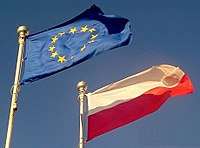
A shock therapy programme, initiated by Leszek Balcerowicz in the early 1990s, enabled the country to transform its socialist-style planned economy into a market economy. As with other post-communist countries, Poland suffered declines in social and economic standards,[115] but it became the first post-communist country to reach its pre-1989 GDP levels, which it achieved by 1995 thanks largely to its booming economy.[116][117]
Most visibly, there were numerous improvements in human rights, such as freedom of speech, internet freedom (no censorship), civil liberties (1st class) and political rights (1st class), as ranked by Freedom House non-governmental organization. In 1991, Poland became a member of the Visegrád Group and joined the North Atlantic Treaty Organization (NATO) alliance in 1999 along with the Czech Republic and Hungary. Poles then voted to join the European Union in a referendum in June 2003, with Poland becoming a full member on 1 May 2004.
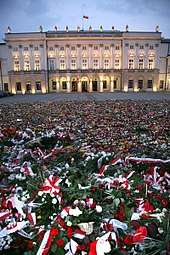
Poland joined the Schengen Area in 2007, as a result of which, the country's borders with other member states of the European Union have been dismantled, allowing for full freedom of movement within most of the EU.[118] In contrast to this, a section of Poland's eastern border now constitutes the external EU border with Belarus, Russia and Ukraine. That border has become increasingly well protected, and has led in part to the coining of the phrase 'Fortress Europe', in reference to the seeming 'impossibility' of gaining entry to the EU for citizens of the former Soviet Union.
In an effort to strengthen military cooperation with its neighbors, Poland set up the Visegrád Battlegroup with Hungary, Czech Republic and Slovakia, with a total of 3,000 troops ready for deployment. Also, in east Poland, it formed the LITPOLUKRBRIG battle groups with Lithuania and Ukraine. These battle groups will operate outside of NATO and within the European defense initiative framework.[119]
On 10 April 2010, the President of the Republic of Poland, Lech Kaczyński, along with 89 other high-ranking Polish officials died in a plane crash near Smolensk, Russia. The president's party was on their way to attend an annual service of commemoration for the victims of the Katyń massacre when the tragedy took place.
In 2011, the ruling Civic Platform won parliamentary elections. Poland joined the European Space Agency in 2012, as well as organised the UEFA Euro 2012 (along with Ukraine). In 2013, Poland also became a member of the Development Assistance Committee. In 2014, the Prime Minister of Poland, Donald Tusk, was chosen to be President of the European Council, and resigned as prime minister. The 2015 elections were won by the opposition Law and Justice Party (PiS).[120]
Geography
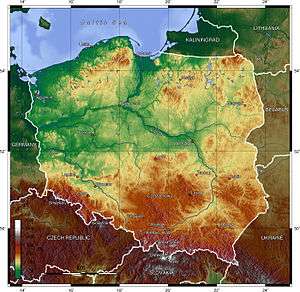
Poland's territory extends across several geographical regions, between latitudes 49° and 55° N, and longitudes 14° and 25° E. In the north-west is the Baltic seacoast, which extends from the Bay of Pomerania to the Gulf of Gdańsk. This coast is marked by several spits, coastal lakes (former bays that have been cut off from the sea), and dunes. The largely straight coastline is indented by the Szczecin Lagoon, the Bay of Puck, and the Vistula Lagoon.
The centre and parts of the north of the country lie within the North European Plain. Rising above these lowlands is a geographical region comprising four hilly districts of moraines and moraine-dammed lakes formed during and after the Pleistocene ice age. These lake districts are the Pomeranian Lake District, the Greater Polish Lake District, the Kashubian Lake District, and the Masurian Lake District. The Masurian Lake District is the largest of the four and covers much of north-eastern Poland. The lake districts form part of the Baltic Ridge, a series of moraine belts along the southern shore of the Baltic Sea.
South of the Northern European Plain are the regions of Lusatia, Silesia and Masovia, which are marked by broad ice-age river valleys. Farther south is a mountainous region, including the Sudetes, the Kraków-Częstochowa Uplands, the Świętokrzyskie Mountains, and the Carpathian Mountains, including the Beskids. The highest part of the Carpathians is the Tatra Mountains, along Poland's southern border.
Geology

The geological structure of Poland has been shaped by the continental collision of Europe and Africa over the past 60 million years and, more recently, by the Quaternary glaciations of northern Europe. Both processes shaped the Sudetes and the Carpathian Mountains. The moraine landscape of northern Poland contains soils made up mostly of sand or loam, while the ice age river valleys of the south often contain loess. The Polish Jura, the Pieniny, and the Western Tatras consist of limestone, while the High Tatras, the Beskids, and the Karkonosze are made up mainly of granite and basalts. The Polish Jura Chain has some of the oldest rock formation on the continent of Europe.
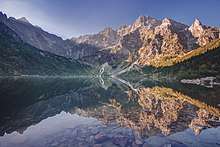
Poland has 70 mountains over 2,000 metres (6,600 feet) in elevation, all in the Tatras. The Polish Tatras, which consist of the High Tatras and the Western Tatras, is the highest mountain group of Poland and of the entire Carpathian range. In the High Tatras lies Poland's highest point, the north-western summit of Rysy, 2,499 metres (8,199 ft) in elevation. At its foot lie the mountain lakes of Czarny Staw pod Rysami (Black Lake below Mount Rysy) and Morskie Oko (the Eye of the Sea), both naturally-made tarns.[121]
The second highest mountain group in Poland is the Beskids, whose highest peak is Babia Góra, at 1,725 metres (5,659 ft). The next highest mountain groups are the Karkonosze in the Sudetes, the highest point of which is Śnieżka at 1,603 metres (5,259 ft), and the Śnieżnik Mountains, the highest point of which is Śnieżnik at 1,425 metres (4,675 ft).
Other notable uplands include the Table Mountains, which are noted for their interesting rock formations, the Bieszczady Mountains in the far southeast of the country, in which the highest Polish peak is Tarnica at 1,346 metres (4,416 ft), the Gorce Mountains in Gorce National Park, whose highest point is Turbacz at 1,310 metres (4,298 ft), the Pieniny in Pieniny National Park, the highest point of which is Wysokie Skałki (Wysoka) at 1,050 metres (3,445 ft), and the Świętokrzyskie Mountains in Świętokrzyski National Park, which have two similarly high peaks: Łysica at 612 metres (2,008 ft) and Łysa Góra at 593 metres (1,946 ft).
The lowest point in Poland – at 1.8 metres (5.9 ft) below sea level – is at Raczki Elbląskie, near Elbląg in the Vistula Delta.
In the Zagłębie Dąbrowskie (the Coal Fields of Dąbrowa) region in the Silesian Voivodeship in southern Poland is an area of sparsely vegetated sand known as the Błędów Desert. It covers an area of 32 square kilometres (12 sq mi). It is not a natural desert but results from human activity from the Middle Ages onwards.
The Baltic Sea activity in Słowiński National Park created sand dunes which in the course of time separated the bay from the sea creating two lakes. As waves and wind carry sand inland the dunes slowly move, at a rate of 3 to 10 metres (9.8 to 32.8 ft) per year. Some dunes reach the height of up to 30 metres (98 ft). The highest peak of the park is Rowokol (115 metres or 377 feet above sea level).
Waters
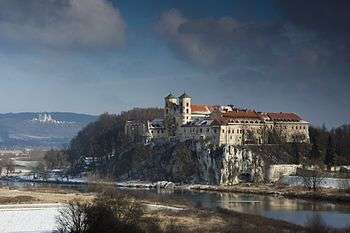
The longest rivers are the Vistula (Polish: Wisła), 1,047 kilometres (651 mi) long; the Oder (Polish: Odra) which forms part of Poland's western border, 854 kilometres (531 mi) long; its tributary, the Warta, 808 kilometres (502 mi) long; and the Bug, a tributary of the Vistula, 772 kilometres (480 mi) long. The Vistula and the Oder flow into the Baltic Sea, as do numerous smaller rivers in Pomerania.[122]
The Łyna and the Angrapa flow by way of the Pregolya to the Baltic Sea, and the Czarna Hańcza flows into the Baltic Sea through the Neman. While the great majority of Poland's rivers drain into the Baltic Sea, Poland's Beskids are the source of some of the upper tributaries of the Orava, which flows via the Váh and the Danube to the Black Sea. The eastern Beskids are also the source of some streams that drain through the Dniester to the Black Sea.

Poland's rivers have been used since early times for navigation. The Vikings, for example, traveled up the Vistula and the Oder in their longships. In the Middle Ages and in early modern times, when the Polish–Lithuanian Commonwealth was the breadbasket of Europe;[123] the shipment of grain and other agricultural products down the Vistula toward Gdańsk and onward to other parts of Europe took on great importance.[123]
In the valley of Pilica river in Tomaszów Mazowiecki there is a unique natural karst spring of water containing calcium salts, that is an object of protection in Niebieskie Źródła Nature Reserve in Sulejów Landscape Park. The origin of the name of the reserve Niebieskie Źródła, that means Blue Springs, comes from the fact that red waves are absorbed by water and only blue and green are reflected from the bottom of the spring, giving that atypical colour.[124]
With almost ten thousand closed bodies of water covering more than 1 hectare (2.47 acres) each, Poland has one of the highest numbers of lakes in the world. In Europe, only Finland has a greater density of lakes.[125] The largest lakes, covering more than 100 square kilometres (39 sq mi), are Lake Śniardwy and Lake Mamry in Masuria, and Lake Łebsko and Lake Drawsko in Pomerania.

In addition to the lake districts in the north (in Masuria, Pomerania, Kashubia, Lubuskie, and Greater Poland), there are also many mountain lakes in the Tatras, of which the Morskie Oko is the largest in area. The lake with the greatest depth—of more than 100 metres (328 ft)—is Lake Hańcza in the Wigry Lake District, east of Masuria in Podlaskie Voivodeship.
Among the first lakes whose shores were settled are those in the Greater Polish Lake District. The stilt house settlement of Biskupin, occupied by more than one thousand residents, was founded before the 7th century BC by people of the Lusatian culture.
Lakes have always played an important role in Polish history and continue to be of great importance to today's modern Polish society. The ancestors of today's Poles, the Polanie, built their first fortresses on islands in these lakes. The legendary Prince Popiel ruled from Kruszwica tower erected on the Lake Gopło.[126] The first historically documented ruler of Poland, Duke Mieszko I, had his palace on an island in the Warta River in Poznań. Nowadays the Polish lakes provide a location for the pursuit of water sports such as yachting and wind-surfing.
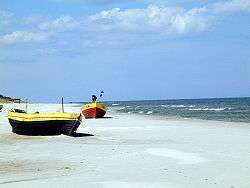
The Polish Baltic coast is approximately 528 kilometres (328 mi) long and extends from Świnoujście on the islands of Usedom and Wolin in the west to Krynica Morska on the Vistula Spit in the east. For the most part, Poland has a smooth coastline, which has been shaped by the continual movement of sand by currents and winds. This continual erosion and deposition has formed cliffs, dunes, and spits, many of which have migrated landwards to close off former lagoons, such as Łebsko Lake in Słowiński National Park.
The largest spits are Hel Peninsula and the Vistula Spit. The coast line is varied also by Szczecin and Vistula Lagoons and a few lakes, e.g. Łebsko and Jamno. The largest Polish Baltic island is called Wolin known for its Wolin National Park. The largest sea harbours are Szczecin, Świnoujście, Gdańsk, Gdynia, Police and Kołobrzeg and the main coastal resorts – Świnoujście, Międzydzdroje, Kołobrzeg, Łeba, Sopot, Władysławowo and the Hel Peninsula.
Land use
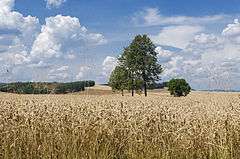
Forests cover about 30.5% of Poland's land area based on international standards.[127] Its overall percentage is still increasing. Forests of Poland are managed by the national program of reforestation (KPZL), aiming at an increase of forest-cover to 33% in 2050. The richness of Polish forest (per SoEF 2011 statistics) is more than twice as high as European average (with Germany and France at the top), containing 2.304 billion cubic metres of trees.[127] The largest forest complex in Poland is Lower Silesian Wilderness.
More than 1% of Poland's territory, 3,145 square kilometres (1,214 sq mi), is protected within 23 Polish national parks. Three more national parks are projected for Masuria, the Polish Jura, and the eastern Beskids. In addition, wetlands along lakes and rivers in central Poland are legally protected, as are coastal areas in the north. There are over 120 areas designated as landscape parks, along with numerous nature reserves and other protected areas (e.g. Natura 2000).
Since Poland's accession to the European Union in 2004, Polish agriculture has performed extremely well and the country has over two million private farms.[128][129] It is the leading producer in Europe of potatoes and rye (world's second largest in 1989) the world's largest producer of triticale,[130] and one of the more important producers of barley, oats, sugar beets, flax, and fruits. Poland is the European Union's fourth largest supplier of pork after Germany, Spain and France.[131]
Biodiversity
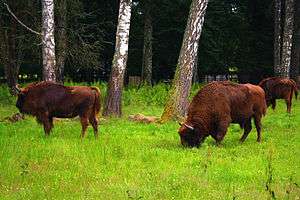
Phytogeographically, Poland belongs to the Central European province of the Circumboreal Region within the Boreal Kingdom. According to the World Wide Fund for Nature, the territory of Poland belongs to three Palearctic Ecoregions of the continental forest spanning Central and Northern European temperate broadleaf and mixed forest ecoregions as well as the Carpathian montane conifer forest.
Many animals that have since died out in other parts of Europe still survive in Poland, such as the wisent in the ancient woodland of the Białowieża Forest and in Podlaskie. Other such species include the brown bear in Białowieża, in the Tatras, and in the Beskids, the gray wolf and the Eurasian lynx in various forests, the moose in northern Poland, and the beaver in Masuria, Pomerania, and Podlaskie.
In the forests there are game animals, such as red deer, roe deer and wild boar. In eastern Poland there are a number of ancient woodlands, like Białowieża forest, that have never been cleared or disturbed much by people. There are also large forested areas in the mountains, Masuria, Pomerania, Lubusz Land and Lower Silesia.
Poland is the most important breeding ground for a variety of European migratory birds.[133] One quarter of the global population of white storks (40,000 breeding pairs) live in Poland,[134] particularly in the lake districts and the wetlands along the Biebrza, the Narew, and the Warta, which are part of nature reserves or national parks.
Poland has historically been home to the two largest European species of mammals — wisent (żubr) and aurochs (tur). Both survived in Poland longer than anywhere else. The last aurochs of Europe became extinct in 1627, in the Jaktorów Forest, while European wood bisons survived until the 20th century only in the Białowieża Forest, but have been reintroduced to other countries since.
Climate
The climate is mostly temperate throughout the country. The climate is oceanic in the north and west and becomes gradually warmer and continental towards the south and east. Summers are generally warm, with average temperatures between 18 and 30 °C (64.4 and 86.0 °F) depending on the region. Winters are rather cold, with average temperatures around 3 °C (37.4 °F) in the northwest and −6 °C (21 °F) in the northeast. Precipitation falls throughout the year, although, especially in the east, winter is drier than summer.[135]
The warmest region in Poland is Lower Silesia in the southwest of the country, where temperatures in the summer average between 24 and 32 °C (75 and 90 °F) but can go as high as 34 to 39 °C (93.2 to 102.2 °F) on some days in the warmest months of July and August. The warmest cities in Poland are Tarnów in Lesser Poland, and Wrocław in Lower Silesia. The average temperatures in Wrocław are 20 °C (68 °F) in the summer and 0 °C (32.0 °F) in the winter, but Tarnów has the longest summer in all of Poland, which lasts for 115 days, from mid-May to mid-September. The coldest region of Poland is in the northeast in the Podlaskie Voivodeship near the borders with Belarus and Lithuania. Usually the coldest city is Suwałki. The climate is affected by cold fronts which come from Scandinavia and Siberia. The average temperature in the winter in Podlaskie ranges from −6 to −4 °C (21 to 25 °F). The biggest impact of the oceanic climate is observed in Świnoujście and Baltic Sea seashore area from Police to Słupsk.[136]
| Location | July (°C) | July (°F) | January (°C) | January (°F) |
|---|---|---|---|---|
| Warsaw | 25/14 | 77/58 | 1/−4 | 33/24 |
| Kraków | 25/13 | 77/56 | 1/−5 | 33/23 |
| Wrocław | 26/14 | 78/57 | 3/−3 | 37/26 |
| Poznań | 25/14 | 77/57 | 2/–3 | 35/26 |
| Gdańsk | 21/13 | 71/55 | 1/−4 | 34/25 |
Government and politics
Poland is a representative democracy, with a president as a head of state, whose current constitution dates from 1997.[138][139] The government structure centers on the Council of Ministers, led by a prime minister. The president appoints the cabinet according to the proposals of the prime minister, typically from the majority coalition in the Sejm. The president is elected by popular vote every five years. The current president is Andrzej Duda and the prime minister is Mateusz Morawiecki.[140]
Polish voters elect a bicameral parliament consisting of a 460-member lower house (Sejm) and a 100-member Senate (Senat). The Sejm is elected under proportional representation according to the d'Hondt method, a method similar to that used in many parliamentary political systems. The Senat, on the other hand, is elected under the first-past-the-post voting method, with one senator being returned from each of the 100 constituencies.[141]
With the exception of ethnic minority parties, only candidates of political parties receiving at least 5% of the total national vote can enter the Sejm. When sitting in joint session, members of the Sejm and Senat form the National Assembly (the Zgromadzenie Narodowe). The National Assembly is formed on three occasions: when a new president takes the oath of office; when an indictment against the President of the Republic is brought to the State Tribunal (Trybunał Stanu); and when a president's permanent incapacity to exercise his duties due to the state of his health is declared. To date only the first instance has occurred.[142]
The judicial branch plays an important role in decision-making. Its major institutions include the Supreme Court (Sąd Najwyższy); the Supreme Administrative Court (Naczelny Sąd Administracyjny); the Constitutional Tribunal (Trybunał Konstytucyjny); and the State Tribunal (Trybunał Stanu). On the approval of the Senat, the Sejm also appoints the ombudsman or the Commissioner for Civil Rights Protection (Rzecznik Praw Obywatelskich) for a five-year term. The ombudsman has the duty of guarding the observance and implementation of the rights and liberties of Polish citizens and residents, of the law and of principles of community life and social justice.[143]
Law
The Constitution of Poland is the supreme law in contemporary Poland, and the Polish legal system is based on the principle of civil rights, governed by the code of Civil Law. Historically, the most famous Polish legal act is the Constitution of 3 May 1791. Historian Norman Davies describes it as the first of its kind in Europe.[144] The Constitution was instituted as a Government Act (Polish: Ustawa rządowa) and then adopted on 3 May 1791 by the Sejm of the Polish–Lithuanian Commonwealth. Primarily, it was designed to redress long-standing political defects of the federative Polish–Lithuanian Commonwealth and its Golden Liberty. Previously only the Henrician Articles (1573) signed by each of Poland's elected kings could perform the function of a set of basic laws.
The new Constitution introduced political equality between townspeople and the nobility (szlachta), and placed the peasants under the protection of the government. The Constitution abolished pernicious parliamentary institutions such as the liberum veto, which at one time had placed the Sejm at the mercy of any deputy who might choose, or be bribed by an interest or foreign power, to have rescinded all the legislation that had been passed by that Sejm. The 3 May Constitution sought to supplant the existing anarchy fostered by some of the country's reactionary magnates, with a more egalitarian and democratic constitutional monarchy. The adoption of the constitution was treated as a threat by Poland's neighbours.[145] In response Prussia, Austria and Russia formed an anti-Polish alliance and over the next decade collaborated with one another to partition their weaker neighbour and destroyed the Polish state. In the words of two of its co-authors, Ignacy Potocki and Hugo Kołłątaj, the constitution represented "the last will and testament of the expiring Fatherland." Despite this, its text influenced many later democratic movements across the globe.[146] In Poland, freedom of expression is guaranteed by the Article 25 (section I. The Republic) and Article 54 (section II. The Freedoms, Rights and Obligations of Persons and Citizens) of the Constitution of Poland.
Prior to the last Partition in 1795, tax-paying females were allowed to take part in political life. Since 1918, following the return to independence, all women could vote. Poland was the 15th (12th sovereign) country to introduce universal women's suffrage. Currently, in Poland abortion is allowed only in special circumstances, such as when the woman's life or health is endangered by the continuation of pregnancy, when the pregnancy is a result of a criminal act, or when the fetus is seriously malformed.[147][148]
Poland's current constitution was adopted by the National Assembly of Poland on 2 April 1997, approved by a national referendum on 25 May 1997, and came into effect on 17 October 1997. It guarantees a multi-party state, the freedoms of religion, speech and assembly, and specifically casts off many Communist ideals to create a 'free market economic system'. It requires public officials to pursue ecologically sound public policy and acknowledges the inviolability of the home, the right to form trade unions, and to strike, whilst at the same time prohibiting the practices of forced medical experimentation, torture and corporal punishment.
Foreign relations
Poland is the fifth most populous member state of the European Union and has a grand total of 52 representatives in the European Parliament as of 2020.[149] Since joining the union in 2004, successive Polish governments have pursued policies to extend the country's role in European and international affairs. Poland is an important hub for international relations and a regional power in Central Europe, with the largest economy of the Three Seas Initiative.[150] The capital of Warsaw serves as the headquarters for Frontex,[151] the European Union's agency for external border security as well as ODIHR, one of the principal institutions of the Organization for Security and Cooperation in Europe.[152]
Apart from the European Union, Poland has been a member of NATO since 1999, the UN, the World Trade Organization, the Organisation for Economic Co-operation and Development (OECD) since 1996, European Economic Area, International Energy Agency, Council of Europe, Organization for Security and Co-operation in Europe, International Atomic Energy Agency, European Space Agency, G6, Council of the Baltic Sea States, Visegrád Group, Weimar Triangle and Schengen Agreement. Poland also guested as an invitee at the G20 summit due to its economic prominence in the region. In 2014, the consulting company Ernst & Young published a report which defined Poland as an 'optimal member' of the G20.[153]
Post-war communist Poland, then known as the Polish People's Republic, was a key member of the Eastern Bloc and the Warsaw Pact, which was signed in Warsaw on 14 May 1955. The treaty acted as a balance of power[154] or counterweight[155] to NATO, which was then headed by western capitalist states. The People's Republic was more liberal than other communist countries in Europe[156] at the time and the Polish communist government maintained neutral or warm ties with Western Europe, the United States and vice versa.[157] As changes since the fall of communism in 1989 have redrawn the map of Europe, Poland has tried to forge strong and mutually beneficial relations with its seven new neighbours; this has notably included signing 'friendship treaties' to replace links severed by the disintegration disintegration of the Warsaw Pact. Poland has also established extensive relations with Ukraine,[158] in an effort to firmly anchor that country within the Western world and prevent the Ukrainians from forming an alliance with the Russian Federation.[158]
Over the past two decades, Poland significantly strengthened its ties with the United States, thus becoming one of its closest allies in Europe. Poland was part of the US-led coalition force during the Iraq War in 2003, and sent its troops in the first phase of the conflict, jointly with the United Kingdom and Australia. In recent years, Poland also sought to become a mediator between the Trump administration and the European Union in solving European disputes.[159][160]
Administrative divisions
Poland's current voivodeships (provinces) are largely based on the country's historic regions, whereas those of the past two decades (to 1998) had been centred on and named for individual cities. The new units range in area from less than 10,000 square kilometres (3,900 sq mi) for Opole Voivodeship to more than 35,000 square kilometres (14,000 sq mi) for Masovian Voivodeship. Administrative authority at voivodeship level is shared between a government-appointed voivode (governor), an elected regional assembly (sejmik) and a voivodeship marshal, an executive elected by that assembly.
The voivodeships are subdivided into powiats (often referred to in English as counties), and these are further divided into gminas (also known as communes or municipalities). Major cities normally have the status of both gmina and powiat. Poland has 16 voivodeships, 380 powiats (including 66 cities with powiat status), and 2,478 gminas.
| ||||||||||||||||||||||||||||||||||||||||||||||||||||||
Military
.jpg)
The Polish armed forces are composed of five branches: Land Forces (Wojska Lądowe), Navy (Marynarka Wojenna), Air Force (Siły Powietrzne), Special Forces (Wojska Specjalne) and Territorial Defence Force (Wojska Obrony Terytorialnej) – a military component of the Polish armed forces created of 2016. Plans call for the force, once fully active, to consist of 53,000 people who will be trained and equipped to counter potential hybrid warfare threats.[161] The military is subordinate to the Minister for National Defence. However, its commander-in-chief is the President of the Republic.
The Polish army's size is estimated at around 101,500 soldiers (2016). The Polish Navy primarily operates in the Baltic Sea and conducts operations such as maritime patrol, search and rescue for the section of the Baltic under Polish sovereignty, as well as hydrographic measurements and research. Also, the Polish Navy played a more international role as part of the 2003 invasion of Iraq, providing logistical support for the United States Navy. The current position of the Polish Air Force is much the same; it has routinely taken part in Baltic Air Policing assignments, but otherwise, with the exception of a number of units serving in Afghanistan, has seen no active combat. In 2003, the F-16C Block 52 was chosen as the new general multi-role fighter for the air force, the first deliveries taking place in November 2006.
.jpg)
The most important mission of the armed forces is the defence of Polish territorial integrity and Polish interests abroad.[162] Poland's national security goal is to further integrate with NATO and European defence, economic, and political institutions through the modernisation and reorganisation of its military.[162] The armed forces are being re-organised according to NATO standards, and since 2010, the transition to an entirely contract-based military has been completed. Compulsory military service for men was discontinued in 2008. From 2007, until conscription ended in 2008, the mandatory service was nine months.[163]
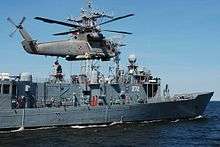
Polish military doctrine reflects the same defensive nature as that of its NATO partners. From 1953 to 2009 Poland was a large contributor to various United Nations peacekeeping missions.[162][164] The Polish Armed Forces took part in the 2003 invasion of Iraq, deploying 2,500 soldiers in the south of that country and commanding the 17-nation Multinational force in Iraq.
The military was temporarily, but severely, affected by the 2010 Polish Air Force Tu-154 crash, which killed the Chief of the Army's General Staff Franciszek Gągor and Air Force commanding general Andrzej Błasik, among others.[165][166]
Currently, Poland's military is going through a significant modernization phase, which will be completed in 2022. The government plans to spend up to 130 billion złoty (US$34 billion), however the final total may reach 235 billion złoty (US$62 billion) to replace dated equipment and purchase new weapons systems.[167] Under the program, the military plans to purchase new tracked armoured personnel carriers, self-propelled howitzers, utility and attack helicopters, a mid-range surface-to-air missile system, attack submarines, minehunters, and coastal anti-ship missiles. Also, the army plans to modernize its existing inventory of main battle tanks, and update its stock of small arms.[168][169] Poland is currently spending 2% of its GDP on defense, and is expected to grow to 2.5% of GDP by 2030. In May 2017 the Ministry of National Defence has assured that the Polish army will be increased to 250,000 active personnel.
Law enforcement and emergency services
Poland has a highly developed system of law enforcement with a long history of effective policing by the State Police Service (Policja). The structure of law enforcement agencies within Poland is a multi-tier one, with the State Police providing criminal-investigative services, Municipal Police serving to maintain public order and a number of other specialized agencies, such as the Polish Border Guard, acting to fulfill their assigned missions. In addition to these state services, private security companies are also common, although they possess no powers assigned to state agencies, such as, for example, the power to make an arrest or detain a suspect.
Emergency services in Poland consist of the emergency medical services, search and rescue units of the Polish Armed Forces and State Fire Service. Emergency medical services in Poland are, unlike other services, provided for by local and regional government.
Since joining the European Union in 2004 all of Poland's emergency services underwent major restructuring and have, in the process, acquired large amounts of new equipment and trained staff.[170][171] All emergency services personnel are uniformed and security services can be easily recognized during regular patrols in both large urban areas or smaller suburban localities.
Economy
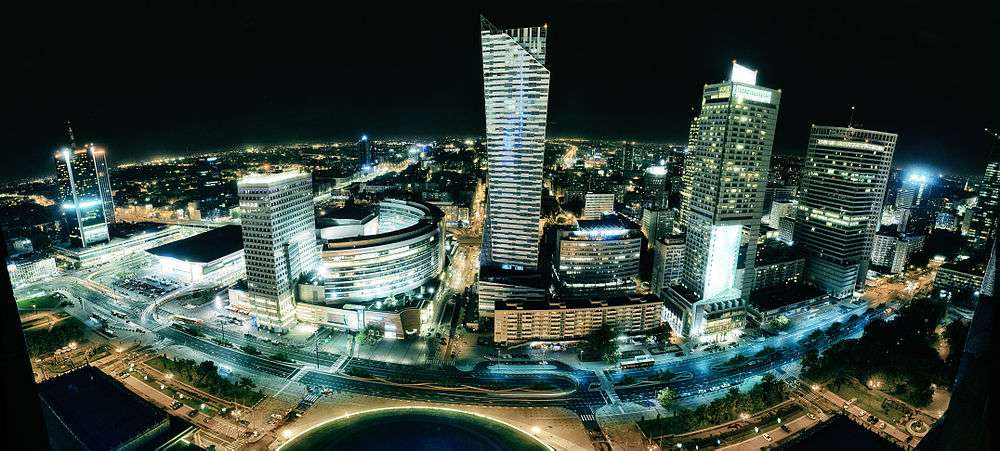
Poland's economy and Gross Domestic Product (GDP) is currently the sixth largest in the European Union by nominal standards, and the fifth largest by purchasing power parity. It is also one of the fastest growing within the Union.[172] Around 60% of the employed population belongs to the tertiary service sector, 30% to industry and manufacturing, and the remaining 10% to the agricultural sector.[173] Although Poland is a member of EU's single market, the country has not adopted the Euro as legal tender and maintains its own currency – the Polish złoty (zł, PLN).
Having a strong domestic market, low private debt, low unemployment rate, flexible currency, and not being dependent on a single export sector, Poland is the only European economy to have avoided the recession of 2008.[174] Since the fall of the communist government, Poland has pursued a policy of liberalising the economy. It is an example of the transition from a centrally planned to a primarily market-based economy. The country is the 25th largest exporter of goods and services in the world and its most successful exports include machinery, furniture, food products, clothing, shoes and cosmetics.[175][176] These account to approximately 55% of the total GDP, as of 2018.[177] Poland's largest trading partners include Germany, Czech Republic, United Kingdom, France and Italy.[178][179]
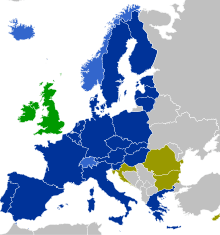
The Polish banking sector is the largest in the Central and Eastern European region,[180] with 32.3 branches per 100,000 adults.[181][182] The banks are the largest and most developed sector of the country's financial markets. They are regulated by the Polish Financial Supervision Authority. During the transformation to a market-oriented economy, the government privatized several banks, recapitalized the rest, and introduced legal reforms that made the sector more competitive. This has attracted a significant number of strategic foreign investors (ICFI). Poland's banking sector has approximately 5 national banks, a network of nearly 600 cooperative banks and 18 branches of foreign-owned banks. In addition, foreign investors have controlling stakes in nearly 40 commercial banks, which make up 68% of the banking capital.[180]
Poland has many private farms in its agricultural sector, with the potential to become a leading producer of food in the European Union. The biggest money-makers abroad include smoked and fresh fish, fine chocolate, and dairy products, meats and specialty breads,[183] with the exchange rate conducive to export growth.[184] Structural reforms in health care, education, the pension system, and state administration have resulted in larger-than-expected fiscal pressures. Warsaw leads Central Europe in foreign investment.[185]
.jpg)
Since the gradual opening of the European Union labour market from 2004, Poland has experienced mass emigration of over 2.3 million nationals, due to higher wages abroad and high unemployment at home, even as Poland avoided the Great Recession of 2008.[186][187][188] The emigration has increased the average wages for the workers who remained in Poland, in particular for those with intermediate level skills.[189] Unemployment also gradually decreased; in September 2018 the unemployment rate in Poland was estimated at 5.7%, one of the lowest in the European Union.[190] In 2019, Poland passed a law that would exempt workers under the age of 26 from income tax.[191]
Products and goods manufactured in Poland include: electronics, buses and trams (Solaris, Solbus), helicopters and planes (PZL Świdnik, PZL Mielec), trains (Pesa SA, Newag), ships (Gdańsk Shipyard, Szczecin Shipyard, Gdynia Polish Navy Shipyard), military equipment (FB "Łucznik" Radom, Bumar-Łabędy SA), medicines (Polpharma, Polfa), food (Tymbark, Hortex, E. Wedel), clothes (LLP), glass, pottery (Bolesławiec), chemical products and others. Poland is also one of the world's biggest producers of copper, silver and coal, as well as potatoes, rye, rapeseed, cabbage, apples, strawberries and ribes.[192]
Corporations
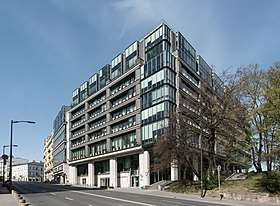
Poland is recognised as a regional economic leader within Central Europe, with nearly 40 percent of the 500 biggest companies in the region (by revenues) as well as a high globalisation rate.[193] The country's largest firms compose the WIG30 index, which is traded on the Warsaw Stock Exchange.
The economic transition in 1989 has resulted in a dynamic increase in the number and value of investments conducted by Polish corporations abroad. Over a quarter of these companies have participated in a foreign project or joint venture, and 72 percent decided to continue foreign expansion. According to reports made by the National Bank of Poland, the value of Polish foreign direct investments reached almost 300 billion PLN at the end of 2014. The Central Statistical Office estimated that in 2014 there were around 1,437 Polish corporations with interests in 3,194 foreign entities.[194]
Well known Polish brands include, among others PKO Bank Polski, PKN Orlen, PGE Energy, PZU, PGNiG, Tauron Group, Lotos Group, KGHM Polska Miedź, Asseco, Plus, Play, LOT Polish Airlines, Poczta Polska, Polish State Railways (PKP), Biedronka, and TVP.[195]
The list includes the largest companies by turnover in 2016:
| Rank 2016[196] | Corporation | Sector | Headquarters | Revenue (billions EUR) | Employees |
|---|---|---|---|---|---|
| 1. | PKN Orlen SA | Oil and gas | Płock | 18.6 | 19,730 |
| 2. | PGNiG | Oil and gas | Gdańsk | 7.7 | 25,271 |
| 3. | PGE SA | Energy | Warsaw | 6.6 | 44,317 |
| 4. | PZU SA | Insurance | Warsaw | 8.5 | 36,419 |
| 5. | Grupa Lotos SA | Oil and gas | Gdańsk | 4.9 | 33,071 |
| 6. | KGHM Polska Miedź SA | Mining | Lubin | 4.6 | 18,578 |
| 7. | Tauron Group SA | Energy | Katowice | 4.1 | 26,710 |
| 8. | Cinkciarz.pl Sp. z o.o. | Financial services | Zielona Góra | 3.3 | 22,556 |
| 9. | PKO BP | Banking | Warsaw | 3.2 | 29,441 |
| 10. | Enea SA | Energy | Poznań | 2.6 | 23,805 |
Tourism
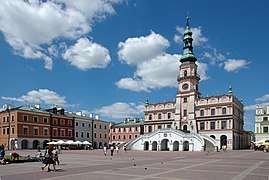
Poland experienced a significant increase in the number of tourists after joining the European Union in 2004.[197][198] With nearly 21 million international arrivals in 2019, tourism contributes considerably to the overall economy and makes up a relatively large proportion of the country's service market.[199][200]
Tourist attractions in Poland vary, from the mountains in the south to the sandy beaches in the north, with a trail of nearly every architectural style. The most visited city is Kraków, which was the former capital of Poland and serves as a relic of the Polish Golden Age and the Renaissance. Kraków also held royal coronations of most Polish kings and monarchs at Wawel, the nation's chief historical landmark. Among other notable sites in the country is Wrocław, one of the oldest cities in Poland, famous for its dwarfs. Wrocław possesses a large market square with two city halls, as well as the oldest Zoological Gardens with one of the world's largest number of animal species. The Polish capital Warsaw and its historical Old Town were entirely reconstructed after wartime destruction. Other cities attracting countless tourists include Gdańsk, Poznań, Lublin, Toruń as well as the site of the German Auschwitz concentration camp in Oświęcim. A notable highlight is the 13th-century Wieliczka Salt Mine with its labyrinthine tunnels, a subterranean lake and chapels carved by miners out of rock salt beneath the ground.
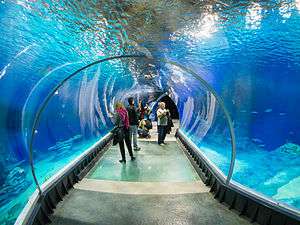
Poland's main tourist offerings include outdoor activities such as skiing, sailing, mountain hiking and climbing, as well as agrotourism, sightseeing historical monuments. Tourist destinations include the Baltic Sea coast in the north; the Masurian Lake District and Białowieża Forest in the east; on the south Karkonosze, the Table Mountains and the Tatra Mountains, where Rysy, the highest peak of Poland, and the famous Orla Perć mountain trail are located. The Pieniny and Bieszczady Mountains lie in the extreme south-east.[201] There are over 100 castles in the country, many in the Lower Silesian Voivodeship and along the popular Trail of the Eagles' Nests.[202] The largest castle in the world by land area is situated in Malbork, in north-central Poland.[203]
Energy
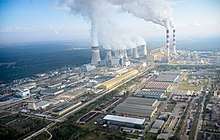
The electricity generation sector in Poland is largely fossil-fuel–based. Many power plants nationwide use Poland's position as a major European exporter of coal to their advantage by continuing to use coal as the primary raw material in production of their energy. In 2013, Poland scored 48 out of 129 states in the Energy Sustainability Index.[204] The three largest Polish coal mining firms (Węglokoks, Kompania Węglowa and JSW) extract around 100 million tonnes of coal annually. All three of these companies are key constituents of the Warsaw Stock Exchange's lead economic indexes.
Renewable forms of energy account for a smaller proportion of Poland's full energy generation capacity.[205] However, the national government has set targets for the development of renewable energy sources in Poland which should see the portion of power produced by renewable resources climb to 15% in 2020 (in 2017 it was 10.9%). This is to be achieved mainly through the construction of wind farms and a number of hydroelectric stations.
Poland has around 164,800,000,000 m3 of proven natural gas reserves and around 96,380,000 barrels of proven oil reserves. These reserves are exploited by energy supply companies such as PKN Orlen ("the only Polish company listed in the Fortune Global 500"), PGNiG. However, the small amounts of fossil fuels naturally occurring in Poland is insufficient to satisfy the full energy consumption needs of the population. Therefore, the country is a net importer of oil and natural gas.
The 5 largest companies supplying Poland electricity are PGE, Tauron, Enea, Energa and Innogy Poland.
Transport
Transport in Poland is provided by means of rail, road, marine shipping and air travel. Positioned in Central Europe with its eastern and part of its northeastern border constituting the longest land border of the Schengen Area with the rest of Northern and Central Europe.
Since joining the EU in May 2004, Poland has invested large amounts of public funds into modernization projects of its extensive transport networks. The country has a good network of highways, composed of express roads and motorways. At the start of 2020, Poland had 4,146.5 km (2,576.5 mi) of highways in use.[206] In addition, all local and regional roads are monitored by the National Road Rebuilding Programme, which aims to improve the quality of travel in the countryside and suburban localities.[207]
The longest European route - E40 runs through Poland.
_Lichen99.jpg)
In 2017, the nation had 18,513 kilometres (11,503 mi) of railway track, the third longest in Europe after Germany and France.[208] Polish authorities maintain a program of improving operating speeds across the entire Polish rail network. To that end, Polish State Railways (PKP) is adopting new rolling stock which is in principle capable of speeds up to 200 km/h (124 mph). Additionally, in December 2014, Poland began to implement high–speed rail routes connecting major Polish cities. The Polish government has revealed that it intends to connect all major cities to a future high-speed rail network by 2020.[209] The new PKP Pendolino ETR 610 test train set the record for the fastest train in the history of Poland, reaching 291 km/h (181 mph) on 24 November 2013. On 14 December 2014, Polish State Railways started passenger service using the PKP Pendolino ED250, operating at 200 km/h on the Central Rail Line (CMK). Poland is gradually implementing the European Rail Traffic Management System. Polish regulations allow trains without ETCS to travel at speeds up to 160 km/h, trains with ETCS1 up to 200 km/h, and trains with ETCS2 over 200 km/h. Most interregional connections rail routes in Poland is operated by PKP Intercity, whilst regional trains are run by a number of operators, the largest of which is Polregio. The largest passenger train station in terms of the number of travelers is Wrocław Główny.
.jpg)
The air and maritime transport markets in Poland are largely well developed. Poland has a number of international airports, the largest of which is Warsaw Chopin Airport, the primary global hub for LOT Polish Airlines. It was established in 1929 from a merger of Aerolloyd (1922) and Aero (1925). Other major airports with international connections include John Paul II International Airport Kraków–Balice, Copernicus Airport Wrocław, Gdańsk Lech Wałęsa Airport. Poland has begun preparations for a construction that can handle 100 million passengers of the Central Communication Port.
Seaports exist all along Poland's Baltic coast, with most freight operations using Świnoujście, Police, Szczecin, Kołobrzeg, Gdynia, Gdańsk and Elbląg as their base. Passenger ferries link Poland with Scandinavia all year round; these services are provided from Gdańsk and Świnoujście by Polferries, Stena Line from Gdynia and Unity Line from the Świnoujście. The Port of Gdańsk is the only port in the Baltic Sea adapted to receive oceanic vessels.
Science and technology

Over the course of history, the Polish people have made considerable contributions in the fields of science, technology and mathematics.[211] Perhaps the most renowned Pole to support this theory was Nicolaus Copernicus (Mikołaj Kopernik), who triggered the Copernican Revolution by placing the Sun rather than the Earth at the center of the universe.[212] He also derived a quantity theory of money, which made him a pioneer of economics. Copernicus' achievements and discoveries are considered the basis of Polish culture and cultural identity.[213]
Poland's tertiary education institutions; traditional universities, as well as technical, medical, and economic institutions, employ around tens of thousands of researchers and staff members. There are hundreds of research and development institutes.[214] However, in the 19th and 20th centuries many Polish scientists worked abroad; one of the most important of these exiles was Maria Skłodowska-Curie, a physicist and chemist who lived much of her life in France. In 1925 she established Poland's Radium Institute.[210]

In the first half of the 20th century, Poland was a flourishing centre of mathematics. Outstanding Polish mathematicians formed the Lwów School of Mathematics (with Stefan Banach, Stanisław Mazur, Hugo Steinhaus, Stanisław Ulam) and Warsaw School of Mathematics (with Alfred Tarski, Kazimierz Kuratowski, Wacław Sierpiński and Antoni Zygmund). Numerous mathematicians, scientists, chemists or economists emigrated due to historic vicissitudes, among them Benoit Mandelbrot, Leonid Hurwicz, Alfred Tarski, Joseph Rotblat and Nobel Prize laureates Roald Hoffmann, Georges Charpak and Tadeusz Reichstein.
Over 40 research and development centers and 4,500 researchers make Poland the biggest research and development hub in Central and Eastern Europe.[215][216] Multinational companies such as: ABB, Delphi, GlaxoSmithKline, Google, Hewlett–Packard, IBM, Intel, LG Electronics, Microsoft, Motorola, Siemens and Samsung all have set up research and development centres in Poland.[217] Companies chose Poland because of the availability of highly qualified labour force, presence of universities, support of authorities, and the largest market in East-Central Europe.[215] According to a KPMG report from 2011, 80% of Poland's current investors are content with their choice and willing to reinvest.[218]
Communications
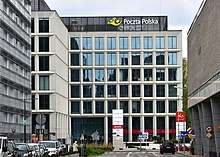
The public postal service in Poland is operated by Poczta Polska (the Polish Post). It was created on 18 October 1558, when King Sigismund II Augustus established a permanent postal route from Kraków to Venice.[219] The service was dissolved during the foreign partitions in the 18th century. After regaining independence in 1918, Poland's postal system developed rapidly as new services were introduced including money transfers, payment of pensions, delivery of magazines, and air mail. The government-owned enterprise of Polish Post, Telegraph and Telephone (Polska Poczta, Telegraf i Telefon) was established in 1928.[220]
During wars and national uprisings, communication was provided mainly through the military authorities. Many important events in the history of Poland involved the postal service, like the defence of the Polish Post Office in Gdańsk in 1939, and the participation of the Polish Scouts' Postal Service in the Warsaw Uprising.
At present, the service is a modern state-owned company that provides a number of standard and express delivery as well as home-delivery services. With an estimated number of around 83,000 employees (2013),[221] Poczta Polska also has a personal tracking system for parcels. In 2017 the company adopted a strategy that assumes increasing revenues to 6.9 billion PLN by 2021; the aim is to double revenues from courier and parcel services and a five-fold growth in logistics services.[222]
Demographics
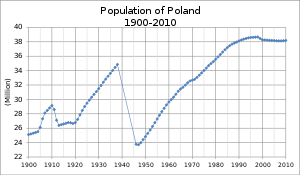
Poland, with its 38,544,513 inhabitants, has the eighth-largest population in Europe and the fifth-largest in the European Union. It has a population density of 122 inhabitants per square kilometer (328 per square mile).
In recent years, Poland's population has decreased due to an increase in emigration and a decline in the birth rate. Since Poland's accession to the European Union on 1 May 2004, a significant number of Poles have emigrated, primarily to the United Kingdom, Germany and Ireland in search of better work opportunities abroad.[223] Since 2012, the economy has improved, and emigration has decreased which allowed the nation to focus on expanding its workforce.[224]
As a result, the Polish Minister of Development Mateusz Morawiecki suggested that Poles abroad should return to Poland.[225] Polish minorities are still present in the neighboring countries of Ukraine, Belarus, and Lithuania, as well as in other countries (see Poles for population numbers). Altogether, the number of ethnic Poles living abroad is estimated to be around 20 million.[226] The largest number of the Polish diaspora can be found in the United States, Germany, United Kingdom and Canada.[227] The total fertility rate (TFR) in Poland was estimated in 2016 at 1.39 children born to a woman.[228] Poland has an average age of 41.1 years.[229]
Urbanization
Languages
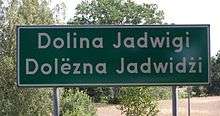
Polish (język polski) belongs to the Lechitic subgroup of West Slavic languages, with close relations to Czech language and Slovak.[230] It is the official and predominant spoken language in Poland, but it is also used throughout the world by Polish minorities in other countries as well as being one of the official languages of the European Union. Its written standard is the Polish alphabet, which has 9 additions to the letters of the Latin script (ą, ć, ę, ł, ń, ó, ś, ź, ż), with the notable exclusion of q,v, and x, which are used mainly for foreign or borrowed words. The deaf communities use Polish Sign Language belonging to the German family of Sign Languages.
According to the Act of 6 January 2005 on national and ethnic minorities and on the regional languages,[231] 16 other languages have officially recognized status of minority languages: 1 regional language (Kashubian – spoken by around 366,000 people,[232][233][234] but only 108,000 declared its everyday use in the census of 2011[235]), 10 languages of 9 national minorities (minority groups that have their own independent state elsewhere) and 5 languages of 4 ethnic minorities (spoken by the members of minorities not having a separate state elsewhere). Jewish and Romani minorities each have 2 minority languages recognized.
Languages having the status of national minority's language are Armenian, Belarusian, Czech, German, Yiddish, Hebrew, Lithuanian, Russian, Slovak and Ukrainian. Languages having the status of ethnic minority's language are Karaim, Rusyn (called Lemko in Poland) and Tatar. Also, official recognition is granted to two Romani languages: Polska Roma and Bergitka Roma.[236]
Official recognition of a language provides certain rights (under conditions prescribed by the law): of education in that language, of having the language established as the secondary administrative language or help language in bilingual municipalities and of financial support from the state for the promotion of that language.
More than 50% of Polish citizens declare knowledge of the English language, followed by German (38%) and Russian (34%).[237][238]
Ethnicity
- Main articles: Polish tribes, Poles, List of notable Poles, Ethnic minorities in Poland
The formation of the Polish identity and ethnicity can be traced to the 10th century when Duke Mieszko I politically unified the Lechitic tribes of Western Polans, Mazovians, Silesians, Vistulans, Pomeranians, Lendians and others,[239][240] which inhabited the area of central Europe between the Oder River in the west and the Bug River in the east, and between the Carpathian and Sudetes mountains in the south and the Baltic sea in the north. Then by accepting Christianity, under the auspices of the Latin Church.[241]
Following the formation of the Polish–Lithuanian Commonwealth in 1569, the country over the next two centuries contained many languages, cultures and religions.[4] The Commonwealth was primarily composed of three nations: Poles, Lithuanians, and Ruthenians (Ukrainians and Belarusians) — there were also sizable minorities of groups such as Germans, Jews, Latvians, Scots, Armenians, Mennonites and Tatars.[242][243] After the partitions of Poland at the end of the 18th century, the bulk of the ethnic Polish population was primarily located in Congress Poland, and in the Galicia and Poznań provinces. When Poland regained its independence in 1918, Poles constituted the majority of the population in the country, during the interwar period, with sizable Ukrainian, Belarusian, Jewish and German minorities.[244]
Today, Poland is primarily inhabited by ethnic Poles. In the 2011 census, 37,310,341 (96.88%) reported Polish as their first identity, 435,750 (1.13%) Silesian, 17,746 (0.04%) Kashubian, 74,464 (0.19%) German, 38,387 (0.09%) Ukrainian, and 36,399 (0.09%) Belarusian. Other identities were reported by 88,577 people (0.23%) and 521,470 people (1.35%) did not report any identity.[2][3] Other minority national and ethnic groups in Poland include the Romani, Polish Jews, Lemkos, Lithuanians, Armenians, Vietnamese, Slovaks, Czechs, Russians, Greeks and Lipka Tatars. Ethnic Poles themselves can be divided into many diverse regional ethnographic sub-groups, such as Masovians, Kurpie, Masurians, Kashubians, Kujawiacy, Poznaniacy, Krakowiacy, Lubliniacy, Lachy Sądeckie, Pogórzanie, Gorals, Silesians and Silesian Gorals among many others.
The statistics on Ukrainians do not include recently arrived migrant workers.[245][246] More than 1.7 million Ukrainian citizens worked legally in Poland in 2017.[247]
Religion
For centuries the Lechitic people inhabiting the lands of modern-day Poland have practiced various forms of paganism known as Rodzimowierstwo, or "native faith".[248][249][250][251] In the year 966, Duke Mieszko I converted to Christianity, and submitted to the authority of the Roman Catholic Church.[252][253] This event came to be known as the Baptism of Poland.[254][255][256] However, this did not put an end to pagan beliefs in the country. The persistence was demonstrated by a series of rebellions known as the Pagan reaction in the first half of the 11th century, which also showed elements of a peasant uprising against landowners and feudalism,[257] and led to a mutiny that destabilized the country.[258][258][259][260]
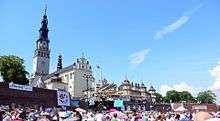
Since then, Poland has been a predominantly Catholic nation, however throughout its history, religious tolerance was an important part of its political culture. In 1264, the Statute of Kalisz, also known as a Charter of Jewish Liberties, granted Jews living in the Polish lands unprecedented legal rights not found anywhere in Europe. In 1424, the Polish king was pressed by the Bishops to issue the Edict of Wieluń, outlawing early Protestant Hussitism. Then in 1573, the Warsaw Confederation marked the formal beginning of extensive religious freedoms granted to all faiths in the Polish-Lithuanian Commonwealth. The act was not imposed by a king or consequence of war, but rather resulted from the actions of members of the Polish-Lithuanian society. It was also influenced by the events of the 1572 French St. Bartholomew's Day Massacre, which prompted the Polish-Lithuanian nobility to see that no monarch would ever be able to carry out such reprehensible atrocities in Poland. The act is also credited with keeping the Polish-Lithuanian Commonwealth out of the Thirty Years' War, fought between German Protestants and Catholics.[261]
.jpg)
Religious tolerance in Poland spurred many theological movements such as Calvinist Polish Brethren and a number of other Protestant groups, as well as atheists, such as ex-Jesuit philosopher Kazimierz Łyszczyński, one of the first atheist thinkers in Europe. Also, in the 16th century, Anabaptists from the Netherlands and Germany settled in Poland—after being persecuted in Western Europe—and became known as the Vistula delta Mennonites.
In 2014, an estimated 87% of the population belonged to the Catholic Church. Though rates of religious observance are lower at 52%,[262][263] Poland remains one of the most religious countries in Europe.[264] Contemporary religious minorities include Polish Orthodox (about 506,800),[8] various Protestants (about 150,000) — including 77,500 Lutherans in the Evangelical-Augsburg Church,[8] 23,000 Pentecostals in the Pentecostal Church in Poland, 10,000 Adventists in the Seventh-day Adventist Church and other smaller Evangelical denominations[8] — Jehovah's Witnesses (126,827),[8] Eastern Catholics, Mariavites, Jews, and Muslims, including the Tatars of Białystok region. There are also several thousand neopagans, some of whom are members of the Native Polish Church.
From 16 October 1978 until his death on 2 April 2005, Karol Józef Wojtyła was Pope of the Roman Catholic Church. He is the only Polish Pope to date.[265] Additionally he is credited with having played a significant role in hastening the downfall of communism in Poland and throughout Central and Eastern Europe.[266][267]
Freedom of religion is guaranteed by the 1989 statute of the Polish Constitution,[268] enabling the emergence of additional denominations.[269] The Concordat between the Holy See and Poland guarantees the teaching of religion in state[270] schools. According to a 2007 survey, 72% of respondents were not opposed to religious instruction in public schools; alternative courses in ethics are available only in one percent of the entire public educational system.[271]
Famous sites of Roman Catholic pilgrimage in Poland include the Monastery of Jasna Góra in the southern Polish city of Częstochowa, Basilica of Our Lady of Licheń, Divine Mercy Sanctuary, Kraków. Many tourists also visit the Family home of John Paul II in Wadowice outside Kraków. Christ the King is the tallest statue of Jesus in the world.[272] Christian Orthodox pilgrims visit Mount Grabarka near Grabarka-Klasztor and the Hasidic Jews travel annually to the grave of a great rabbi in Leżajsk.[273]
Health
Poland's healthcare system is based on an all-inclusive insurance system. State subsidised healthcare is available to all Polish citizens who are covered by this general health insurance program. However, it is not compulsory to be treated in a state-run hospital as a number of private medical complexes exist nationwide.[274]
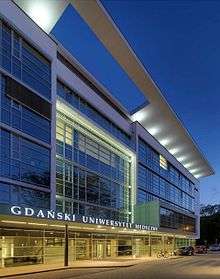
All medical service providers and hospitals in Poland are subordinate to the Polish Ministry of Health, which provides oversight and scrutiny of general medical practice as well as being responsible for the day-to-day administration of the healthcare system. In addition to these roles, the ministry is tasked with the maintenance of standards of hygiene and patient-care.
Hospitals in Poland are organised according to the regional administrative structure, resultantly most towns have their own hospital (Szpital Miejski).[275] Larger and more specialised medical complexes tend only to be found in larger cities, with some even more specialised units located only in the capital, Warsaw. However, all voivodeships have their own general hospital (most have more than one), all of which are obliged to have a trauma centre; these types of hospital, which are able to deal with almost all medical problems are called 'regional hospitals' (Szpital Wojewódzki). The last category of hospital in Poland is that of specialised medical centres, an example of which would be the Skłodowska-Curie Institute of Oncology, Poland's leading, and most highly specialised centre for the research and treatment of cancer.
In 2012, the Polish health-care industry experienced further transformation. Hospitals were given priority for refurbishment where necessary.[276] As a result of this process, many hospitals were updated with the latest medical equipment.
According to the Human Development Report from 2018, the average life expectancy at birth is 78.5 years (74.6 years for an infant male and 82.4 years for an infant female).[277]
Education
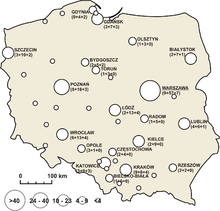
The Commission of National Education (Komisja Edukacji Narodowej) established in 1773, was the world's first state ministry of education.[278][279] The education of Polish society was a goal of the nation's rulers as early as the 12th century. The library catalogue of the Cathedral Chapter of Kraków dating back to 1110 shows that in the early 12th century Polish academia had access to European and Classical literature. The Jagiellonian University was founded in 1364 by King Casimir III in Kraków—the school is the world's 19th oldest university.
As of 2012, Programme for International Student Assessment, coordinated by the Organisation for Economic Co-operation and Development, ranks Poland's educational system higher than the OECD average.[280]:4
Education in Poland starts at the age of five or six (with the particular age chosen by the parents) for the '0' class (Kindergarten) and six or seven years in the 1st class of primary school (Polish szkoła podstawowa). It is compulsory that children participate in one year of formal education before entering the 1st class at no later than 7 years of age. Corporal punishment of children in schools is officially prohibited since 1783 (before the partitions) and criminalised since 2010 (in schools as well as at home).
At the end of the 6th class when students are 13, students take a compulsory exam that will determine their acceptance and transition into a specific lower secondary school (gimnazjum—middle school or junior high). They will attend this school for three years during classes 7, 8, and 9. Students then take another compulsory exam to determine the upper secondary level school they will attend. There are several alternatives, the most common being the three years in a liceum or four years in a technikum. Both end with a maturity examination (matura—similar to French baccalauréat), and may be followed by several forms of higher education, leading to licencjat or inżynier (the Polish Bologna Process first cycle qualification), magister (second cycle qualification) and eventually doktor (third cycle qualification).[281]
In Poland, there are 500 university-level institutions for the pursuit of higher education.[282] There are 18 fully accredited traditional universities, 20 technical universities, 9 independent medical universities, 5 universities for the study of economics, 9 agricultural academies, 3 pedagogical universities, a theological academy, 3 maritime service universities and 4 national military academies.[283] Also, there are a number of higher educational institutions dedicated to the teaching of the arts—amongst these are the 7 academies of music.[283]
Culture
The culture of Poland is closely connected with its intricate 1,000-year history and forms an important constituent in western civilization.[284] With origins in the culture of the tribal Lechites, over time Polish culture has been influenced by its interweaving ties with the neighbouring Germanic and Latinate worlds as well as in continual dialogue with the many other ethnic groups and minorities living in Poland.[285] The people of Poland have traditionally been seen as hospitable to artists from abroad and eager to follow cultural and artistic trends popular in other countries. In the 19th and 20th centuries the Polish focus on cultural advancement often took precedence over political and economic activity. These factors have contributed to the versatile nature of Polish art.[285]
The appreciation of Poland's traditions, history and cultural heritage is commonly known as Polonophilia.
Music


Artists from Poland, including famous musicians such as Chopin, Rubinstein, Paderewski, Penderecki and Wieniawski, and traditional, regionalized folk composers create a lively and diverse music scene, which even recognizes its own music genres, such as sung poetry and disco polo.
The origins of Polish music can be traced to the 13th century; manuscripts have been found in Stary Sącz containing polyphonic compositions related to the Parisian Notre Dame School. Other early compositions, such as the melody of Bogurodzica and God Is Born (a coronation polonaise for Polish kings by an unknown composer), may also date back to this period, however, the first known notable composer, Nicholas of Radom, lived in the 15th century. During the 16th century, two main musical groups – both based in Kraków and belonging to the King and Archbishop of Wawel – led to the rapid development of Polish renaissance music. Diomedes Cato, a native-born Italian who lived in Kraków from about the age of five, became a renowned lutenist at the court of Sigismund III, and not only imported some of the musical styles from southern Europe, but blended them with native folk music.[286]
In the 17th and 18th centuries, Polish baroque composers mostly wrote either liturgical music or secular compositions such as concertos and sonatas for voices or instruments. At the end of the 18th century, Polish classical music evolved into national forms like the polonaise. Also, Wojciech Bogusławski's Krakowiacy i Górale, which premiered in 1794, is regarded as the first Polish national opera.
Traditional Polish folk music has had a major effect on the works of many well-known Polish composers, and no more so than on Fryderyk Chopin, a widely recognised national hero of the arts. All of Chopin's works involve the piano and are technically demanding, emphasising nuance and expressive depth. As a great composer, Chopin invented the musical form known as the instrumental ballade and made major innovations to the piano sonata, mazurka, waltz, nocturne, polonaise, étude, impromptu and prélude, he was also the composer of a number of polonaises which borrowed heavily from traditional Polish folk music. It is largely thanks to him that such pieces gained great popularity throughout Europe during the 19th century. Several Polish composers such as Szymanowski would later go on to draw inspiration from Chopin's folk-influenced style. Nowadays the most distinctive folk music can be heard in the towns and villages of the mountainous south, particularly in the region surrounding the winter resort town of Zakopane.
Today Poland has an active music scene, with the jazz and metal genres being particularly popular among the contemporary populace. Polish jazz musicians such as Krzysztof Komeda created a unique style, which was most famous in the 1960s and 1970s and continues to be popular to this day. Since the fall of communism throughout Europe, Poland has become a major venue for large-scale music festivals, chief among which are the Open'er Festival, Opole Festival and Sopot Festival.
Art
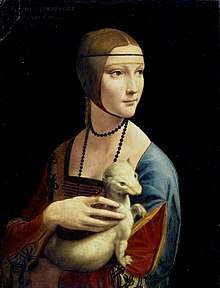
Art in Poland has always reflected European trends while maintaining its unique character. The Kraków Academy of Fine Arts, later developed by Jan Matejko, produced monumental portrayals of customs and significant events in Polish history.[288] Other institutions such as the Academy of Fine Arts in Warsaw were more innovative and focused on both historical and contemporary styles.[289] In recent years, art academies such as the Kraków School of Art and Fashion Design, Art Academy of Szczecin, University of Fine Arts in Poznań and Geppert Academy of Fine Arts in Wrocław gained much recognition.
Perhaps the most prominent and internationally admired Polish artist was Tamara de Lempicka, who specialized in the style of Art Deco.[290] Lempicka was described as "the first woman artist to become a glamour star."[291] Another notable was Caziel, born Zielenkiewicz, who represented Cubism and Abstraction in France and England.[292]
Prior to the 19th century only Daniel Schultz and Italian-born Marcello Bacciarelli had the privilege of being recognized abroad. The Young Poland movement witnessed the birth of modern Polish art, and engaged in a great deal of formal experimentation led by Jacek Malczewski, Stanisław Wyspiański, Józef Mehoffer, and a group of Polish Impressionists.[293] Stanisław Witkiewicz was an ardent supporter of Realism, its main representative being Józef Chełmoński, while Artur Grottger specialized in Romanticism. Within historically-orientated circles, Henryk Siemiradzki dominated with his monumental Academic Art and ancient Roman theme.[294]
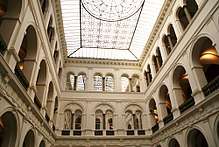
Since the inter-war years, Polish art and documentary photography has enjoyed worldwide fame and in the 1960s the Polish School of Posters was formed.[285] Throughout the entire country, many national museum and art institutions hold valuable works by famous masters. Major museums in Poland include the National Museum in Warsaw, Poznań, Wrocław, Kraków, and Gdańsk, as well as the Museum of John Paul II Collection, and the Wilanów Museum. Important collections are also held at the Royal Castle in Warsaw, Wawel Castle and in the Palace on the Isle. The most distinguished painting of Poland is Lady with an Ermine by Leonardo da Vinci, held at the Czartoryski Museum in Kraków. Although not Polish, the work had a strong influence on Polish culture and has been often associated with Polish identity.[295]
Architecture
Polish cities and towns reflect a whole spectrum of European architectural styles. Romanesque architecture is represented by St. Andrew's Church, Kraków, and St. Mary's Church, Gdańsk, is characteristic for the Brick Gothic style found in Poland. Richly decorated attics and arcade loggias are the common elements of the Polish Renaissance architecture,[296][297] as evident in the City Hall in Poznań. For some time the late renaissance style known as mannerism, most notably in the Bishop's Palace in Kielce, coexisted with the early baroque style, typified in the Church of Saints Peter and Paul in Kraków.

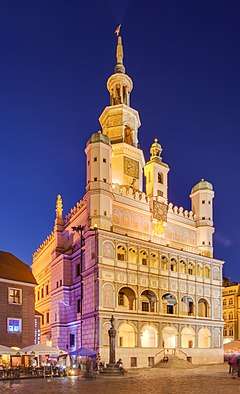
History has not been kind to Poland's architectural monuments. Nonetheless, a number of ancient structures has survived: castles, churches, and stately homes, often unique in the regional or European context. Some of them have been painstakingly restored, like Wawel Castle, or completely reconstructed, including the Old Town and Royal Castle of Warsaw and the Old Town of Gdańsk.
The architecture of Gdańsk is mostly of the Hanseatic variety, a Gothic style common among the former trading cities along the Baltic sea and in the northern part of Central Europe. The architectural style of Wrocław is mainly representative of German architecture, since it was for centuries located within the Holy Roman Empire. The centres of Kazimierz Dolny and Sandomierz on the Vistula are good examples of well-preserved medieval towns. Poland's ancient capital, Kraków, ranks among the best-preserved Gothic and Renaissance urban complexes in Europe.
The second half of the 17th century is marked by baroque architecture. Side towers, such as those of Branicki Palace in Białystok, are typical for the Polish baroque. The classical Silesian baroque is represented by the University in Wrocław. The profuse decorations of the Branicki Palace in Warsaw are characteristic of the rococo style. The centre of Polish classicism was Warsaw under the rule of the last Polish king Stanisław II Augustus.[298] The Palace on the Water is the most notable example of Polish neoclassical architecture. Lublin Castle represents the Gothic Revival style in architecture, while the Izrael Poznański Palace in Łódź is an example of eclecticism.
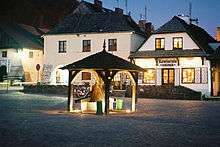
Traditional folk architecture in the villages and small towns scattered across the vast Polish countryside is characterized by its extensive use of wood and bare brick as primary building materials, common for Central Europe. Some of the best preserved and oldest structures include ancient stone temples in Silesia and fortified wooden churches across southeastern Poland in the Beskids and Bieszczady regions of the Carpathian mountains.[299][300] Numerous examples of secular structures such as Polish manor houses (dworek), farmhouses (chata), granaries, mills, barns and country inns (karczma) can still be found across some Polish regions. However, traditional construction methods faded in the first decades of the 1900s, when Poland's population experienced a demographic shift to urban dwelling away form the countryside.
Literature
The earliest Polish literature dates back to the 12th century,[301] when Poland's official language was Latin. Within Polish literary customs, it is appropriate to highlight the published works concerning Poland not written by ethnic Poles. The most vivid example is Gallus Anonymus, a foreign monk and the first chronicler who described Poland and its territories.[302]
The first documented phrase in the Polish language reads "Day ut ia pobrusa, a ti poziwai" ("Let me grind, and you take a rest"), reflecting the culture of early Poland.[303] It was composed by an abbot named Piotr (Peter) within the Latin language chronicle Liber fundationis from between 1269 and 1273, which described the history of the Cistercian monastery in Henryków, Silesia. The sentence was allegedly uttered almost a hundred years earlier by a Bohemian settler, who expressed pity for his spouse's duty of grinding by the quern-stone. The sentence has been included in the UNESCO Memory of World Register.[304]
Most medieval records in Latin and the Old Polish language contain the oldest extant manuscript of fine Polish prose entitled the Holy Cross Sermons, as well as the earliest Polish-language bible, the so-called Bible of Queen Sophia.[305] One of the first printing houses was established by Kasper Straube in the 1470s, while Jan Haller was considered the pioneer of commercial print in Poland. Haller's Calendarium cracoviense, an astronomical wall calendar from 1474, is Poland's oldest surviving print.[306]
The tradition of extending Polish historiography in Latin was subsequently inherited by Vincent Kadłubek, Bishop of Kraków in the 13th century, and Jan Długosz in the 15th century.[307] This practice, however, was abandoned by Jan Kochanowski, who became one of the first Polish Renaissance authors to write most of his works in Polish, along with Mikołaj Rej.[308] Poland also hosted many famed poets and writers from abroad like Filippo "Kallimach" Buonaccorsi, Conrad Celtes and Laurentius Corvinus. A Polish writer who utilized Latin as his principal tool of expression was Klemens "Ianicius" Janicki, one of the most renowned Latin poets of his time, who was laureled by the Pope. Other writers of the Polish Renaissance include Johannes Dantiscus, Andreus Fricius Modrevius, Matthias Sarbievius and Piotr Skarga. Throughout this period Poland also experienced the early stages of Protestant Reformation. The main figure of Polish Reformation was John Laski, who, with the permission of King Edward VI of England, created the European Protestant Congregation of London in 1550.[309]
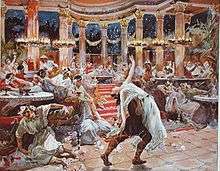
During the Polish Baroque era, the Jesuits greatly influenced Polish literature and literary techniques, often relying on God and religious matters.[310] The leading baroque poet was Jan Andrzej Morsztyn, who incorporated Marinism into his publications. Jan Chryzostom Pasek, also a respected baroque writer, is mostly remembered for his tales and memoirs reflecting sarmatian culture in the Polish-Lithuanian Commonwealth.[311] Subsequently, the Polish Enlightenment was dominated by Samuel Linde, Hugo Kołłątaj, Izabela Czartoryska, Julian Ursyn Niemcewicz and two Polish monarchs, Stanisław I and Stanisław II Augustus. In 1776, Ignacy Krasicki composed the first proper novel entitled The Adventures of Mr. Nicholas Wisdom, which was a milestone for Polish literature.[312]
Among the best known Polish Romantics are the "Three Bards"–the three national poets active in the age of foreign partitions–Adam Mickiewicz, Juliusz Słowacki and Zygmunt Krasiński.[313] Adam Mickiewicz is widely regarded as one of the greatest Polish, Slavic and European poets.[314][315] He is known primarily for the national epic poem Pan Tadeusz, a masterpiece of Polish literature.
A Polish prose poet of the highest order, Joseph Conrad, the son of dramatist Apollo Korzeniowski, won worldwide fame with his English-language novels and stories that are informed with elements of the Polish national experience.[316][317] Conrad's books and published novels like Heart of Darkness, Nostromo and Victory are believed to be one of the finest works ever written, placing Conrad among the greatest novelists of all time.[318][319]
In the 20th century, five Polish novelists and poets were awarded the Nobel Prize in Literature–Henryk Sienkiewicz for Quo Vadis, Władysław Reymont for The Peasants, Isaac Bashevis Singer, Czesław Miłosz and Wisława Szymborska.[320][321] In 2019, Polish author Olga Tokarczuk was awarded the Nobel Prize in Literature for the year 2018.[322]
Cinema
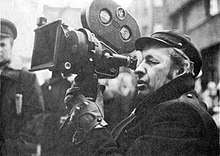
The history of Polish cinema is as long as history of cinematography itself. Over decades, Poland has produced outstanding directors, film producers, cartoonists and actors that achieved world fame, especially in Hollywood. Moreover, Polish inventors played an important role in the development of world cinematography and modern-day television. Among the most famous directors and producers, who worked in Poland as well as abroad are Roman Polański, Andrzej Wajda, Samuel Goldwyn, the Warner brothers (Harry, Albert, Sam, and Jack), Max Fleischer, Lee Strasberg, Agnieszka Holland and Krzysztof Kieślowski.
In the 19th century, throughout partitioned Poland, numerous amateur inventors, such as Kazimierz Prószyński, were eager to construct a film projector. In 1894, Prószyński was successful in creating a Pleograph, one of the first cameras in the world. The invention, which took photographs and projected pictures, was built before the Lumière brothers lodged their patent.[323] He also patented an Aeroscope, the first successful hand-held operated film camera. In 1897, Jan Szczepanik, obtained a British patent for his Telectroscope. This prototype of television could easily transmit image and sound, thus allowing a live remote view. Following the invention of appropriate apparatus and technological development in the upcoming years, his then-impossible concept became reality.[323]
Polish cinema developed rapidly in the interwar period. The most renowned star of the silent film era was Polish actress Pola Negri. During this time, the Yiddish cinema also evolved in Poland. Films in the Yiddish language with Jewish themes, such as The Dybbuk (1937), played an important part in pre-war Polish cinematography. In 1945 the government established 'Film Polski', a state-run film production and distribution organization, with director Aleksander Ford as the head of the company. Ford's Knights of the Teutonic Order (1960) was viewed by millions of people in the Soviet Union, Czechoslovakia and France.[324] This success was followed by the popular historical films of Jerzy Hoffman and Andrzej Wajda. Wajda's 1975 film The Promised Land was nominated at the 48th Academy Awards.[325]
In 2015, Ida by Paweł Pawlikowski won the Academy Award for Best Foreign Language Film.[326] In 2019, Pawlikowski received an Academy Award for Best Director nomination for his historical drama Cold War. Other well-known Polish Oscar-winning productions include The Pianist (2002) by Roman Polański.
Media
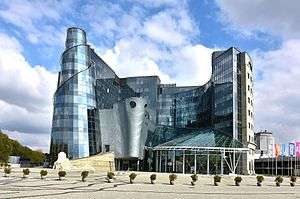
Poland has a number of major media outlets, chief among which are the national television channels. TVP is Poland's public broadcasting corporation; about a third of its income comes from a broadcast receiver licence, while the rest is made through revenue from commercials and sponsorships. State television operates two mainstream channels, TVP 1 and TVP 2, as well as regional programs for each of the country's 16 voivodeships (as TVP 3). In addition to these general channels, TVP runs a number of genre-specific programmes such as TVP Sport, TVP Historia, TVP Kultura, TVP Rozrywka, TVP Seriale and TVP Polonia, the latter is a state-run channel dedicated to the transmission of Polish language television for the Polish diaspora abroad.
Poland has several 24-hour news channels: Polsat News, Polsat News 2, TVP Info, TVN 24, TVN 24 Biznes i Świat, TV Republika and WPolsce.pl.
.jpg)
In Poland, there are also daily newspapers like Gazeta Wyborcza ("Electoral Gazette"), Rzeczpospolita ("The Republic") and Gazeta Polska Codziennie ("Polish Daily Newspaper") which provide traditional opinion and news, and tabloids such as Fakt and Super Express. Rzeczpospolita, founded in 1920 is one of the oldest newspapers still in operation in the country. Weeklies include Tygodnik Angora, W Sieci, Polityka, Wprost, Newsweek Polska, Gość Niedzielny and Gazeta Polska.
Poland has also emerged as a major hub for video game developers in Europe, with the country now being home to hundreds of studios. Among the most successful ones are CD Projekt, Techland, CI Games and People Can Fly.[327] Some of the most popular video games developed in Poland include The Witcher, The Witcher 2: Assassins of Kings and The Witcher 3: Wild Hunt.[328] Other notable games include Bulletstorm, Call of Juarez, Painkiller, Dead Island, Lords of the Fallen, The Vanishing of Ethan Carter, Sniper Ghost Warrior, Dying Light, Shadow Warrior, Gears of War: Judgment, Observer, Layers of Fear, Book of Demons and Cyberpunk 2077.[329][330] Katowice hosts Intel Extreme Masters, one of the biggest eSports events in the world.[331]
Cuisine
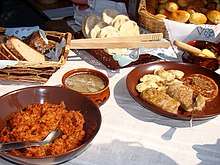
Polish cuisine has evolved over the centuries to become highly eclectic due to Poland's history. Polish cuisine shares many similarities with other Central European cuisines, especially German and Austrian[332] as well as Jewish,[333] French, Italian and Turkish culinary traditions.[334] Polish-styled cooking in other cultures is often referred to as cuisine à la polonaise.[335]
Polish dishes are usually rich in meat, especially pork, chicken and beef (depending on the region), winter vegetables (sauerkraut cabbage in bigos), and spices.[336] It is also characteristic in its use of various kinds of noodles, the most notable of which are kluski, as well as cereals such as kasha (from the Polish word kasza)[337] and a variety of breads like the world-renowned bagel. Polish cuisine is hearty and uses a lot of cream and eggs. Festive meals such as the meatless Christmas Eve dinner (Wigilia) or Easter breakfast could take days to prepare in their entirety.[338]
The main course usually includes a serving of meat, such as roast, chicken, or kotlet schabowy (breaded pork cutlet), vegetables, side dishes and salads, including surówka [suˈrufka] – shredded root vegetables with lemon and sugar (carrot, celeriac, seared beetroot) or sauerkraut (Polish: kapusta kiszona, pronounced [kaˈpusta kʲiˈʂɔna]). The side dishes are usually potatoes, rice or kasza (cereals). Meals conclude with a dessert such as sernik (cheesecake), makowiec (poppy seed pastry), or napoleonka (cream pie), and tea.
The Polish national dishes are bigos [ˈbiɡɔs]; pierogi [pʲɛˈrɔɡʲi]; kielbasa; kotlet schabowy [ˈkɔtlɛt sxaˈbɔvɨ] breaded cutlet; gołąbki [ɡɔˈwɔ̃pkʲi] cabbage rolls; zrazy [ˈzrazɨ] roulade; pieczeń roast [ˈpʲɛt͡ʂɛɲ]; sour cucumber soup (zupa ogórkowa, pronounced [ˈzupa ɔɡurˈkɔva]); mushroom soup, (zupa grzybowa, [ˈzupa ɡʐɨˈbɔva] quite different from the North American cream of mushroom); zupa pomidorowa tomato soup pronounced [ˈzupa pɔmidɔˈrɔva];[339] rosół [ˈrɔɕuw] variety of meat broth; żurek [ˈʐurɛk] sour rye soup; flaki [ˈflakʲi] tripe soup; barszcz [barʂt͡ʂ] and chłodnik [ˈxwɔdɲik] among others.[340]
Traditional alcoholic beverages include honey mead, widespread since the 13th century, beer, wine and vodka (old Polish names include okowita and gorzała).[341] The world's first written mention of vodka originates from Poland.[342] The most popular alcoholic drinks at present are beer and wine which took over from vodka more popular in the years 1980–1998.[343] Tea remains common in Polish society since the 19th century, whilst coffee is drunk widely since the 18th century.[344] Other frequently consumed beverages include various mineral waters and juices, soft drinks popularized by the fast-food chains since the late 20th century, as well as buttermilk, soured milk and kefir.[345]
Sports
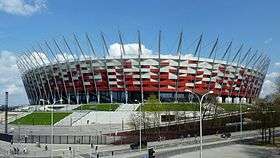
Volleyball and Association football are among the country's most popular sports, with a rich history of international competitions.[346][347] Track and field, basketball, handball, boxing, MMA, motorcycle speedway, ski jumping, cross-country skiing, ice hockey, tennis, fencing, swimming and weightlifting are other popular sports. Notable Polish sportspeople include Zbigniew Boniek, Irena Szewińska, Agnieszka Radwańska, Justyna Kowalczyk, Robert Lewandowski, Kamil Stoch and Anita Włodarczyk.
The golden era of football in Poland occurred throughout the 1970s and went on until the early 1980s when the Polish national football team achieved their best results in any FIFA World Cup competitions finishing 3rd place in the 1974 and the 1982 tournaments. The team won a gold medal in football at the 1972 Summer Olympics and two silver medals, in 1976 and in 1992. Poland, along with Ukraine, hosted the UEFA European Football Championship in 2012.[348]
.jpg)
As of 2019, the Polish men's national volleyball team is ranked as 3rd in the world.[349] Volleyball team won a gold medal in Olympic 1976 Montreal and three gold medals in FIVB World Championship 1974, 2014 and 2018.[350][351] Mariusz Pudzianowski is a highly successful strongman competitor and has won more World's Strongest Man titles than any other competitor in the world, winning the event in 2008 for the fifth time. The first Polish Formula One driver, Robert Kubica, has brought awareness of Formula One racing to Poland. He won the 2008 Canadian Grand Prix, took part in rallying and had a full-time seat for the 2019 F1 season.
Poland has made a distinctive mark in motorcycle speedway racing thanks to Tomasz Gollob, a highly successful Polish rider. The top Ekstraliga division has one of the highest average attendances for any sport in Poland. The national speedway team of Poland, one of the major teams in international speedway,[352] has won the Speedway World Team Cup championships three times consecutively, in 2009, 2010, and 2011. No team has ever managed such feat.[353][354]
Poles made significant achievements in mountaineering, in particular, in the Himalayas and the winter ascending of the eight-thousanders. Polish mountains are one of the tourist attractions of the country. Hiking, climbing, skiing and mountain biking and attract numerous tourists every year from all over the world.[201] Water sports are the most popular summer recreation activities, with ample locations for fishing, canoeing, kayaking, sailing and windsurfing especially in the northern regions of the country.[355]
Fashion and design
Fashion was always an important aspect of Poland and its national identity. Although the Polish fashion industry is not as famed in comparison to the industries of France and Italy, it still contributed to global trends and clothing habits. Moreover, several Polish designers and stylists left a lifelong legacy of beauty inventions and cosmetics, which are still in use nowadays.
Throughout history, the clothing styles in Poland often varied due to foreign influence, especially from the neighbouring countries and the Middle East. By the 17th century, the high-class nobility and magnates wore attire that somewhat mediated between Western and Ottoman styles.[356] The outfits included a żupan, delia, kontusz, and a type of sword called karabela, brought by Armenian merchants. Wealthy Polish aristocrats also kept captive Tatars and Janissaries in their courts; this affected the national dress.[356] The extensive multiculuralism present in the Polish-Lithuanian Commonwealth developed the ideology of "Sarmatism".
_cropped.jpg)
The Polish national dress as well as the fashion and etiquette of Poland also reached the royal court at Versailles in the 1700s. Some French dresses inspired by Polish outfits were called à la polonaise, meaning "Polish-styled". The most famous example is the robe à la polonaise or simply Polonaise, a woman's garment with draped and swagged overskirt, worn over an underskirt or petticoat.[357] Another notable example is the Witzchoura, a long mantle with collar and hood, which was possibly introduced by Napoleon's Polish mistress Maria Walewska.[358] The scope of influence also entailed furniture; rococo Polish beds with canopies became commonplace in French palaces during the 18th century.[359][360]
In the early 20th century, the underdeveloped fashion and cosmetics industry in Congress Poland was heavily dominated by western styles, mostly from the United Kingdom and the United States. This inspired Polish beautician Maksymilian Faktorowicz to seek employment abroad and create a line of cosmetics company called Max Factor in California. In 1920, Faktorowicz invented the conjoined word "make-up" based on the verb phrase "to make up" one's face, which is now used as an alternative for "cosmetics".[361] Faktorowicz also raised to fame by inventing modern eyelash extensions and providing services to Hollywood artists of the era.[362][363]

Another Pole that contributed to the development of cosmetics was Helena Rubinstein, the founder of Helena Rubinstein Incorporated Cosmetics Company, which made her one of the richest women in the world,[364] and was bought by L'Oréal.[365] One of Rubinstein's most controversial quotes was "There are no ugly women, only lazy ones".[365]
Inglot Cosmetics founded in 1983, is Poland's largest beauty products manufacturer and retailer, sold in 700 locations worldwide, including retail salons in New York City, London, Milan, Dubai and Las Vegas.[366][367] Internationally successful models from Poland include Anja Rubik, Joanna Krupa, Jac Jagaciak, Kasia Struss, Małgosia Bela, and Magdalena Frąckowiak.[368]
Established in 1999, the retail store Reserved is Poland's most successful clothing store chain, operating over 1,700 retail shops in 19 countries.[369][370][371]
See also
Notes
- Many declared more than one ethnic or national identity. The percentages of ethnic Poles and of minorities depend on how we count. 94.83% declared exclusively Polish identity, 96.88% declared Polish as their first identity and 97.10% as either first or second identity. Around 98% declared some sort of Polish as their first identity.
- The adoption of Christianity in Poland is seen by many Poles, regardless of their religious affiliation or lack thereof, as one of the most significant events in their country's history, as it was used to unify the Polish tribes.[6]
- The area of Poland, as given by the Central Statistical Office, is 312,679 km2 (120,726 sq mi), of which 311,888 km2 (120,421 sq mi) is land and 791 km2 (305 sq mi) is internal water surface area.[8]
- In other languages of Poland: Kashubian: Repùblika Pòlskô
- The Polish word "sanacja" is defined identically as "ł[aciński]: uzdrowienie (L[atin]: healing) in Słownik wyrazów obcych [Dictionary of Foreign Expressions], 1918 (8 years before Piłsudski's May Coup);[70] and in M. Arcta słownik wyrazów obcych [Michał Arct's Dictionary of Foreign Expressions], 1947.[71] Słownik wyrazów obcych PWN [PWN Dictionary of Foreign Expressions], 1971,[72] defines the expression as follows: "sanacja łac. sanatio = uzdrowienie" (sanation, from Lat[in] sanatio = healing) 1. w Polsce międzywojennej — obóz Józefa Piłsudskiego, który pod hasłem uzdrowienia stosunków politycznych i życia publicznego dokonał przewrotu wojskowego w maju 1926 r.... (1. in interwar Poland, the camp of Józef Piłsudski, who worked in a military coup in May 1926 under the banner of healing politics and public life...) 2. rzad[ko używany]: uzdrowienie, np. stosunków w jakiejś instytucji, w jakimś kraju. (2. rare[ly used]: healing, e.g., of an institution, of a country.)
- British code-breaker Gordon Welchman said: "Ultra would never have gotten off the ground if we had not learned from the Poles, in the nick of time, the details both of the German military version of the commercial Enigma machine, and of the operating procedures that were in use."[79]
- Numerous sources state that Polish Army was the Allies' fourth biggest fighting contingent. Steven J. Zaloga and Richard Hook write that "by the war's end the Polish Army was the fourth largest contingent of the Allied coalition after the armed forces of the Soviet Union, the United States and the United Kingdom".[80] Jerzy Jan Lerski writes "All in all, the Polish units, although divided and controlled by different political orientation, constituted the fourth largest Allied force, after the America, British and Soviet Armies."[81] M. K. Dziewanowski has noted that "if Polish forces fighting in the east and west were added to the resistance fighters, Poland had the fourth largest Allied army in the war (after the USSR, the U.S. and Britain)".[82]
The claim of the fourth biggest Ally needs to be reconsidered, however. Throughout the war, Poland's position varied from the 2nd biggest Ally (after the fall of France, when Polish army outnumbered the French) to perhaps the 5th at the end of it (after the US, Soviet Union, China and Britain). Please see the analysis in Polish contribution to World War II. - Sources vary with regards to what was the largest resistance movement during World War II. The confusion often stems from the fact that as war progressed, some resistance movements grew larger – and other diminished. Polish territories were mostly freed from Nazi German control in the years 1944–45, eliminating the need for their respective (anti-Nazi) partisan forces in Poland (although the cursed soldiers continued to fight against the Soviets). Several sources note that Polish Armia Krajowa was the largest resistance movement in Nazi-occupied Europe. Norman Davies wrote: "Armia Krajowa (Home Army), the AK, which could fairly claim to be the largest of European resistance";[87] Gregor Dallas wrote "Home Army (Armia Krajowa or AK) in late 1943 numbered around 400000, making it the largest resistance organization in Europe";[88] Mark Wyman wrote "Armia Krajowa was considered the largest underground resistance unit in wartime Europe".[89] Certainly, Polish resistance was the largest resistance till German invasion of Yugoslavia and invasion of the Soviet Union in 1941. After that point, the numbers of Soviet partisans and Yugoslav partisans begun growing rapidly. The numbers of Soviet partisans quickly caught up and were similar to that of the Polish resistance.[90][91] The numbers of Tito's Yugoslav partisans were roughly similar to those of the Polish and Soviet partisans in the first years of the war (1941–42), but grew rapidly in the latter years, outnumbering the Polish and Soviet partisans by 2:1 or more (estimates give Yugoslavian forces about 800,000 in 1945, to Polish and Soviet forces of 400,000 in 1944).[91][92]
References
- Constitution of the Republic of Poland, Article 27.
- Struktura narodowo-etniczna, językowa i wyznaniowa ludności Polski. Narodowy Spis Powszechny Ludności i Mieszkań 2011 [National-ethnic, linguistic and religious structure of Poland. National Census of Population and Housing 2011] (PDF) (in Polish). Central Statistical Office. 2015. ISBN 978-83-7027-597-6.
- Ludność. Stan i struktura demograficzno-społeczna. Narodowy Spis Powszechny Ludności i Mieszkań 2011 [Population. Number and demographical-social structure. National Census of Population and Housing 2011] (PDF) (in Polish). Central Statistical Office. 2013. ISBN 978-83-7027-521-1.
- Rykała, Andrzej (2014). "National and Ethnic Minorities in Poland from the Perspective of Political Geography". Acta Universitatis Lodziensis. Folia Geographica Socio-Oeconomica (in Polish). 17: 63–111 – via CEON Biblioteka Nauki.
- GUS. "Infographic – Religiousness of Polish inhabitiants". stat.gov.pl. Retrieved 17 June 2019.
- Christian Smith (1996). Disruptive Religion: The Force of Faith in Social-movement Activism. Psychology Press. ISBN 978-0-415-91405-5. Retrieved 9 September 2013 – via Google Books.
- GUS. "Powierzchnia i ludność w przekroju terytorialnym w 2018 roku".
- "Concise Statistical Yearbook of Poland, 2008" (PDF). Central Statistical Office. 28 July 2008. Archived from the original (PDF) on 28 October 2008. Retrieved 12 August 2008.
- demografia.stat.gov.pl/. "Population. Size and structure and vital statistics in Poland by territorial divison. As of December 31, 2019". stat.gov.pl.
- "World Economic Outlook Database, October 2019". IMF.org. International Monetary Fund. Retrieved 30 October 2019.
- "Gini coefficient of equivalised disposable income – EU-SILC survey". ec.europa.eu. Eurostat. Retrieved 20 March 2020.
- "Human Development Report 2019" (PDF). United Nations Development Programme. 10 December 2019. Retrieved 10 December 2019.
- Johnson, Lonnie R. (1996). Central Europe: enemies, neighbors, friends. Oxford University Press. p. 3. ISBN 978-0-19-802607-5.
- Lukowski, Jerzy; Zawaszki, Hubert (2001). A Concise History of Poland (First ed.). University of Stirling Libraries – Popular Loan (Q 43.8 LUK): Cambridge University Press. p. 3. ISBN 978-0-521-55917-1.CS1 maint: location (link)
- Norman Davies, Europe: A History, Pimlico 1997, p. 554: Poland-Lithuania was another country which experienced its 'Golden Age' during the sixteenth and early seventeenth centuries. The realm of the last Jagiellons was absolutely the largest state in Europe
- Piotr Stefan Wandycz (2001). The price of freedom: a history of East Central Europe from the Middle Ages to the present. Psychology Press. p. 66. ISBN 978-0-415-25491-5. Retrieved 13 August 2011.
- Tatjana Tönsmeyer; Peter Haslinger; Agnes Laba (2018). Coping with Hunger and Shortage under German Occupation in World War II. Springer. p. 188. ISBN 978-3-319-77467-1.
- Materski & Szarota (2009)
- "Warsaw Stock Exchange, Poland, stocks, investing online – Fio bank". Retrieved 9 April 2017.
- "The World Factbook — Central Intelligence Agency". www.cia.gov. Retrieved 12 April 2019.
- "Bloomberg Businessweek: 'How Poland Became Europe's Most Dynamic Economy'". Retrieved 14 April 2017 – via Multishoring.info.
Stephan Faris (27 November 2013). "How Poland Became Europe's Most Dynamic Economy". Bloomberg. Retrieved 14 April 2017. - "Human Development Index and its components" (PDF). hdr.undp.org. Retrieved 27 August 2011.
- Veeke, Justin van der. "Developing Countries – isi-web.org". Archived from the original on 25 April 2017. Retrieved 24 April 2017.
- "Poland Is Europe's Growth Champion. Can This Continue?". 17 February 2019.
- "Country and Lending Groups | Data". Data.worldbank.org. Archived from the original on 18 March 2011. Retrieved 9 November 2010.
- "Quality of Life Index for Country 2018 Mid-Year [Quality of Life Index: 147.53]". Numbeo. Retrieved 16 July 2018.
"Quality of Life Index for Country 2015 Mid Year [Quality of Life Index: 141.79]". Numbeo. Archived from the original on 17 July 2015. - "World's Safest Countries Ranked — CitySafe". Archived from the original on 15 April 2017. Retrieved 14 April 2017.
- "Poland 25th worldwide in expat ranking". Retrieved 14 April 2017.
- Administrator. "Social security in Poland". Archived from the original on 12 March 2016. Retrieved 24 April 2017.
- "Healthcare in Poland – Europe-Cities". Archived from the original on 24 April 2017. Retrieved 24 April 2017.
- Centre, UNESCO World Heritage. "Poland". UNESCO World Heritage Centre.
- "The Many Different Names of Poland". Culture.pl. Retrieved 31 March 2019.
- Henryk Łowmiański "Studia nad dziejami słowiańszczyzny Polski i Rusi w wiekach średnich", UAM, Poznań 1986
- Gardawski, Aleksander; Rajewski, Zdzisław; Gąssowski, Jerzy (6 September 1957). "Archeologia i pradzieje Polski". Państwowe Zakł. Wydawn. – via Google Books.
- Ring, Trudy; Watson, Noelle; Schellinger, Paul (28 October 2013). Northern Europe: International Dictionary of Historic Places. Routledge. ISBN 9781136639449. Retrieved 31 March 2019 – via Google Books.
- "Biskupin 'postarzał się' o 200 lat. 85. rocznica odkrycia osady i 25-lecie ustalenia daty jej założenia". poznan.wyborcza.pl.
- "[Nasz wywiad] Rzymianie na Kujawach – sensacja w polskiej archeologii" [[Our interview] Romans in Kujawy – a sensation in Polish archeology]. Do Rzeczy (in Polish). 28 April 2018.
- Maciej Kosiński; Magdalena Wieczorek-Szmal (2007). Z mroku dziejów. Kultura Łużycka (PDF) (in Polish). Muzeum Częstochowskie. Rezerwat archeologiczny (Museum of Częstochowa). pp. 3–4. ISBN 978-83-60128-11-4. Retrieved 9 January 2013.
Możemy jedynie stwierdzić, że kultura łużycka nie tworzyła jednej zwartej całości. Jak się wydaje, jej skład etniczny był niejednorodny.
- Gerard Labuda (1992). Mieszko II król Polski: 1025–1034 : czasy przełomu w dziejach państwa polskiego. Secesja. p. 112. ISBN 978-83-85483-46-5. Retrieved 26 October 2014.
... w wersji Anonima Minoryty mówi się znowu, iż w Polsce "paliły się kościoły i klasztory", co koresponduje w przekazaną przez Anonima Galla wiadomością o zniszczeniu kościołów katedralnych w Gnieźnie...
- Anita J. Prazmowska (2011). A History of Poland. Palgrave Macmillan. pp. 34–35. ISBN 978-0-230-34537-9. Retrieved 26 October 2014.
- Knoll, Paul W.; Schaer, Frank, eds. (2003), Gesta Principum Polonorum / The Deeds of the Princes of the Poles, Central European Medieval Texts, General Editors János M. Bak, Urszula Borkowska, Giles Constable & Gábor Klaniczay, Volume 3, Budapest/ New York: Central European University Press, pp. 87–211, ISBN 978-963-9241-40-4
- Dembkowski, Harry E. (1982). The union of Lublin, Polish federalism in the golden age. East European Monographs. p. 271. ISBN 978-0-88033-009-1.
- Stanley S. Sokol (1992). The Polish Biographical Dictionary: Profiles of Nearly 900 Poles who Have Made Lasting Contributions to World Civilization. Bolchazy-Carducci Publishers. p. 60. ISBN 978-0-86516-245-7.
- Britannica Educational Publishing (2013). Estonia, Latvia, Lithuania, and Poland. Britannica Educational Publishing. p. 139. ISBN 978-1-61530-991-7.
- Heiko Haumann (2002). A History of East European Jews. Central European University Press. p. 4. ISBN 978-963-9241-26-8.
- Teeple, J. B. (2002). Timelines of World History. Publisher: DK Adult.
- Wróbel, Piotr (2004). "Poland". In Frucht, Richard C. (ed.). Eastern Europe: An Introduction to the People, Lands, and Culture. 1. ABC-CLIO. p. 10. ISBN 978-1-57607-800-6. Retrieved 8 April 2013.
At the same time, when most of Europe was decimated by the Black Death, Poland developed quickly and reached the levels of the wealthiest countries of the West in its economy and culture.
- Jerzy Wyrozumski – Historia Polski do roku 1505 (History of Poland until 1505), Państwowe Wydawnictwo Naukowe (Polish Scientific Publishers PWN), Warszawa 1986, ISBN 978-83-01-03732-1
- Norman Davies (1996). Europe: a history. Oxford University Press. p. 428. ISBN 978-0-19-820171-7.
By 1490 the Jagiellons controlled Poland-Lithuania, Bohemia, and Hungary, but not the Empire.
- "Jagiellon dynasty". Encyclopædia Britannica.
- Davies (2007). Warfare, State and Society on the Black Sea Steppe,1500–1700.. p. 17.
- Eizo Matsuki. "The Crimean Tatars and their Russian-Captive Slaves" (PDF). Mediterranean Studies Group at Hitotsubashi University. Archived from the original (PDF) on 5 June 2013.
- Paul W. Knoll (2011). "Religious Toleration in Sixteenth-Century Poland. Political Realities and Social Constrains.". In Howard Louthan; Gary B. Cohen; Franz A.J. Szabo (eds.). Diversity and Dissent: Negotiating Religious Difference in Central Europe, 1500–1800. Berghahn Books. pp. 30–45. ISBN 978-0-85745-109-5.
- Józef Andrzej Gierowski – Historia Polski 1505–1764 (History of Poland 1505–1764), Państwowe Wydawnictwo Naukowe (Polish Scientific Publishers PWN), Warszawa 1986, ISBN 978-83-01-03732-1
- Józef Andrzej Gierowski – Historia Polski 1505–1764 (History of Poland 1505–1764), pp. 105–173
- "Poland – The 17th-century crisis". Britannica Encyclopedia.
- Józef Andrzej Gierowski – Historia Polski 1505–1764 (History of Poland 1505–1764), pp. 174–301
- Józef Andrzej Gierowski – Historia Polski 1764–1864 [History of Poland 1764–1864], Państwowe Wydawnictwo Naukowe (Polish Scientific Publishers PWN), Warszawa 1986, ISBN 978-83-01-03732-1, pp. 1–74
- Józef Andrzej Gierowski – Historia Polski 1764–1864 (History of Poland 1764–1864), pp. 74–101
- Gardner, Monica Mary (1942). The Rising of Kościuszko (Chapter VII) (Project Gutenberg). Kościuszko: A Biography. G. Allen & Unwin., ltd, 136 pages.
- Storozynski, Alex (2009). The Peasant Prince: Thaddeus Kosciuszko and the Age of Revolution (Google Book). New York: St. Martin's Press, 352 pages. ISBN 978-1-4299-6607-8.
- Lukowski, Jerzy; Zawadzki, W.H. (2001). A Concise History of Poland. Cambridge: Cambridge University Press. p. 313. ISBN 978-0-521-55917-1.
- Kappeler, Andreas (27 August 2014). The Russian Empire: A Multi-ethnic History. Routledge. ISBN 9781317568100 – via Google Books.
- Lucassen, Leo; Feldman, David; Oltmer, Jochen (6 September 2006). Paths of Integration: Migrants in Western Europe (1880–2004). Amsterdam University Press. ISBN 9789053568835 – via Google Books.
- Koryś, Piotr (29 November 2018). Poland From Partitions to EU Accession: A Modern Economic History, 1772–2004. Springer. ISBN 9783319971261 – via Google Books.
- Kressel, Getzel (6 September 1973). Zionism. Keter Books. ISBN 9780706513264 – via Google Books.
- Payk, Marcus M.; Pergher, Roberta (29 March 2019). Beyond Versailles: Sovereignty, Legitimacy, and the Formation of New Polities after the Great War. Indiana University Press. ISBN 9780253040947 – via Google Books.
- Frątczak, Sławomir Z. (2005). "Cud nad Wisłą". Głos (in Polish) (32/2005). Archived from the original on 8 July 2007. Retrieved 18 June 2006.
- Bitter glory: Poland and its fate, 1918 to 1939; p. 179
- Słownik wyrazów obcych [Dictionary of Foreign Expressions], New York, Polish Book Importing Co., 1918, p. 701.
- M. Arcta słownik wyrazów obcych [Michał Arct's Dictionary of Foreign Expressions], Warsaw, Wydawnictwo S. Arcta, 1947, p. 313.
- Słownik wyrazów obcych PWN [PWN Dictionary of Foreign Expressions], Warsaw, Państwowe Wydawnictwo Naukowe, 1971, p. 665.
- "Sanacja ," Encyklopedia Polski, p. 601.
- Porter-Szücs, Brian (6 January 2014). Poland in the Modern World: Beyond Martyrdom. John Wiley & Sons. ISBN 9781118598085 – via Google Books.
- Lerski, Jerzy Jan; Lerski, George J.; Lerski, Halina T.; Gieysztor, Aleksander (6 September 1996). Historical Dictionary of Poland, 966–1945. Greenwood Publishing Group. ISBN 9780313260070 – via Google Books.
- "Russian parliament condemns Stalin for Katyn massacre". BBC News. 26 November 2010
- Michael Geyer (2009). Beyond Totalitarianism: Stalinism and Nazism Compared. Cambridge University Press. pp. 152–153. ISBN 978-0-521-89796-9.
- Kochanski, Halik (2014). The Eagle Unbowed: Poland and the Poles in the Second World War. Harvard University Press. ISBN 978-0-674-06814-8.
- Gordon Welchman, The Hut Six Story, 1982, p. 289.
- Steven J. Zaloga; Richard Hook (1982). The Polish Army 1939–45. Osprey Publishing. pp. 3–. ISBN 978-0-85045-417-8. Retrieved 6 March 2011 – via Google Books.
- Jerzy Jan Lerski (1996). Historical Dictionary of Poland, 966–1945. Greenwood Publishing Group. p. 18. ISBN 978-0-313-26007-0. Retrieved 6 March 2011 – via Google Books.
- E. Garrison Walters (1988). The other Europe: Eastern Europe to 1945. Syracuse University Press. pp. 276–. ISBN 978-0-8156-2440-0. Retrieved 6 March 2011 – via Google Books.
- At the siege of Tobruk
- including the capture of the monastery hill at the Battle of Monte Cassino
- Jerzy Jan Lerski (1996). Historical Dictionary of Poland, 966–1945. Greenwood Publishing Group. p. 34. ISBN 978-0-313-26007-0 – via Google Books.
- Lynne Olson & Stanley Cloud. 2003. A Question of Honor. The Kosciuszko Squadron: Forgotten Heroes of World War II. New York: Knopf.
- Norman Davies, God's Playground: A History of Poland, Columbia University Press, 2005, ISBN 0-231-12819-3, Google Print p. 344
- Gregor Dallas, 1945: The War That Never Ended, Yale University Press, 2005, ISBN 0-300-10980-6, Google Print, p. 79
- Mark Wyman, DPs: Europe's Displaced Persons, 1945–1951, Cornell University Press, 1998, ISBN 0-8014-8542-8, Google Print, p. 34
- See for example: Leonid D. Grenkevich in The Soviet Partisan Movement, 1941–44: A Critical Historiographical Analysis, p. 229 or Walter Laqueur in The Guerilla Reader: A Historical Anthology, New York, Charles Scribiner, 1990, p. 233.
- Velimir Vukšić (2003). Tito's partisans 1941–45. Osprey Publishing. pp. 11–. ISBN 978-1-84176-675-1. Retrieved 1 March 2011.
- Anna M. Cienciala, The Coming of the War and Eastern Europe in World War II, History 557 Lecture Notes
- Stanisław Salmonowicz, Polskie Państwo Podziemne, Wydawnictwa Szkolne i Pedagogiczne, Warszawa, 1994, ISBN 978-83-02-05500-3, p. 37
- The Warsaw Rising, polandinexile.com
- Browning, Christopher R.; Matthäus, Jürgen (2004). The origins of the Final Solution: the evolution of Nazi Jewish policy, September 1939 – March 1942. Comprehensive history of the Holocaust. Lincoln: University of Nebraska Press. ISBN 978-0-8032-1327-2.
- Snyder, Timothy (2015). Black earth: the Holocaust as history and warning (First ed.). New York: Tim Duggan Books. ISBN 978-1-101-90345-2.
- Materski & Szarota (2009) Quote: Liczba Żydów i Polaków żydowskiego pochodzenia, obywateli II Rzeczypospolitej, zamordowanych przez Niemców sięga 2,7- 2,9 mln osób. Translation: The number of Jewish victims is estimated at 2,9 million. This was about 90% of the 3.3 million Jews living in prewar Poland. Source: IPN.
- "Poland Historical Background".
- "Polish Victims". United States Holocaust Memorial Museum.
- Piotrowski, Tadeusz. "Poland World War II casualties (in thousands)".
- Materski & Szarota (2009) Quote: Łączne straty śmiertelne ludności polskiej pod okupacją niemiecką oblicza się obecnie na ok. 2 770 000. Translation: Current estimate is roughly 2,770,000 victims of German occupation. This was 11.3% of the 24.4 million ethnic Poles in prewar Poland.
- "Documenting Numbers of Victims of the Holocaust and Nazi Persecution". United States Holocaust Memorial Museum.
- Wardzyńska, Maria (2009). Był rok 1939. Operacja niemieckiej policji bezpieczeństwa w Polsce. Intelligenzaktion [The Year was 1939: Operation of German Security Police in Poland. Intelligenzaktion] (PDF file) (in Polish). Institute of National Remembrance. ISBN 978-83-7629-063-8.
Oblicza się, że akcja „Inteligencja” pochłonęła ponad 100 tys. ofiar. Translation: It is estimated that Intelligenzaktion took the lives of 100,000 Poles.
CS1 maint: ref=harv (link) - Grzegorz Motyka, Od rzezi wołyńskiej do akcji "Wisła". Konflikt polsko-ukraiński 1943–1947. Kraków 2011, p. 447. See also: Book review by Tomasz Stańczyk: "Grzegorz Motyka oblicza, że w latach 1943–1947 z polskich rąk zginęło 11–15 tys. Ukraińców. Polskie straty to 76–106 tys. zamordowanych, w znakomitej większości podczas rzezi wołyńskiej i galicyjskiej."
- "What were the Volhynian Massacres?". 1943 Wołyń Massacres Truth and Remembrance. Institute of National Remembrance. 2013.
- Holocaust: Five Million Forgotten: Non-Jewish Victims of the Shoah. Remember.org.
- "Polish experts lower nation's WWII death toll". Archived from the original on 18 August 2019.
- Bureau odszkodowan wojennych (BOW), Statement on war losses and damages of Poland in 1939–1945. Warsaw 1947
- Bogumiła Lisocka-Jaegermann (2006). "Post-War Migrations in Poland". In: Mirosława Czerny. Poland in the geographical centre of Europe. Hauppauge, New York: Nova Science Publishers. pp. 71–87. ISBN 1-59454-603-7. Google Books preview.
- Eberhardt, Piotr (2006). Political Migrations in Poland 1939–1948 (PDF). Warsaw: Didactica. ISBN 978-1-5361-1035-7. Archived from the original (PDF) on 26 June 2015.
- Eberhardt, Piotr (2011). Political Migrations On Polish Territories (1939–1950) (PDF). Warsaw: Polish Academy of Sciences. ISBN 978-83-61590-46-0.
- "European Refugee Movements After World War Two". BBC – History.
- Arthur Bliss Lane I saw Poland betrayed: An American Ambassador Reports to the American People. Indianapolis: The Bobbs-Merrill Company, 1948.
- "Polska. Historia". PWN Encyklopedia (in Polish). Archived from the original on 1 October 2006. Retrieved 11 July 2005.
- Kowalik, Tadeusz (2011). From Solidarity to Sell-Out: The Restoration of Capitalism in Poland. New York, NY: Monthly Review Press.
- "Real GDP growth in CEECs". Transitioneconomies.blogspot.com. 28 May 2006. Retrieved 6 May 2009.
- "Why Poland?" (PDF). Archived from the original (PDF) on 25 March 2009. Retrieved 8 July 2009.
- "Europe's border-free zone expands". BBC News. 21 December 2007. Retrieved 28 July 2011.
- Reuters, Ukraine, Poland and Lithuania form joint military unit. Warsaw, 19 September 2014.
- "Poland elections: Conservatives secure decisive win". BBC News. 25 October 2015.
- "Poland – CIA World Factbook". www.ciaworldfactbook.us.
- "Longest Rivers In Poland". WorldAtlas. Retrieved 31 March 2019.
- Timothy Snyder (2003). The Reconstruction of Nations: Poland, Ukraine, Lithuania, Belarus, 1569–1999. Yale University Press. p. 111. ISBN 978-0-300-12841-3.
Commonwealth became the breadbasket of Western Europe, wrote Timothy Snyder, thanks to the presence of fertile southeastern regions of Podolia and east Galicia.
- "Blue Springs of Tomaszow Mazowiecki, Tomaszów Mazowiecki, Poland Tourist Information". Archived from the original on 31 December 2016. Retrieved 1 January 2017.
- Christine Zuchora-Walske (2013). "The Lakes Region". Poland. ABDO Publishing. p. 28. ISBN 978-1-61480-877-0.
Insert: Poland is home to 9,300 lakes. Finland is the only European nation with a higher density of lakes than Poland.
- Ḥayah Bar-Yitsḥaḳ (2001). Jewish Poland – legends of Origin: Ethnopoetics and Legendary Chronicles. Wayne State University Press. p. 93. ISBN 978-0-8143-2789-0.
- Centrum Informacyjne Lasów Państwowych (June 2012). "Raport o stanie lasów w Polsce" [Report on the Status of Forests in Poland] (PDF) (in Polish). Dyrekcja Generalna Lasów Państwowych [Main Directorate of State Forest]. p. 8. Retrieved 14 September 2013.
Określona według standardu międzynarodowego lesistość Polski na koniec roku 2011 wynosiła 30,5%.
- "A golden age for Polish farming?". The Economist. 24 March 2014. Retrieved 23 November 2014.
- "Agrotourism". Polska | Poland's Official Travel Website. Archived from the original on 31 October 2014. Retrieved 24 November 2014.
- Gnel Gabrielyan; Thomas L. Marsh. "Domestic and Export Price Formation of U.S. Hops" (PDF). Washington State University. Archived from the original (PDF) on 26 April 2014. Retrieved 4 May 2014.
- "Agriculture in the European Union. Statistical and Economic Information 2011" (PDF). World production and gross domestic production of main pork-producing or exporting countries. European Union. Directorate-General for Agriculture and Rural Development. p. 307. Retrieved 4 May 2014.
EU: official slaughter only. Source: FAO.
- "About White Stork". Poland.pl. Archived from the original on 8 February 2009. Retrieved 6 May 2009.
- Ministry of Foreign Affairs (2011). "Kingdom of birds". Experience Poland » Geography » Environment » Fauna.
A real kingdom of birds is the Biebrza Basin, its wildlife making it one of the most unique areas in Poland. It is Europe's most valuable peatland/marshland and an important wildfowl breeding area on the continent, providing refuge for 263 bird species, including 185 nesting species.
- Kevin Hillstrom; Laurie Collier Hillstrom (2003). Europe: A Continental Overview of Environmental Issues, Volume 4. ABC-CLIO World geography. p. 34. ISBN 978-1-57607-686-6.
- "The World Factbook — Central Intelligence Agency". www.cia.gov.
- Borówka R., et al. Przyroda Pomorza Zachodniego. Szczecin: Oficyna In Puls; 2002.
- "Poland climate information". Weatherbase. Retrieved 4 February 2016.
- Cienski, Jan (12 October 2019). "Europe's Poland puzzle". POLITICO.
- "Constitutional history of Poland". ConstitutionNet.
- "Kornel Morawiecki funeral mass held in Warsaw". www.thefirstnews.com.
- "IFES Election Guide | Elections: Poland Senate". www.electionguide.org.
- "Zgromadzenie Narodowe". www.sejm.gov.pl. Archived from the original on 7 November 2019. Retrieved 12 November 2019.
- "Trybunał Konstytucyjny i Trybunał Stanu". www.wosna5.pl.
- Davies, Norman (1996). Europe: A History. Oxford University Press. p. 699. ISBN 978-0-19-820171-7 – via Internet Archive.
- Józef Andrzej Gierowski (1986). Historia Polski, 1505–1764 [History of Poland, 1505–1764] (in Polish). Państwowe Wydawnictwo Naukowe. p. 251. ISBN 978-83-01-03732-1. Retrieved 26 October 2014.
- Norman Davies (1996). Europe: A History. Oxford University Press. p. 699. ISBN 978-0-19-820171-7.
- "Historia Centrum Praw Kobiet" [History of the Women's Rights Center]. Centrum Praw Kobiet (in Polish). 2012. Archived from the original on 2 March 2015.
- "Frauen, www.eurotopics.net". Archived from the original on 2 February 2014.
- "Redistribution of seats in the European Parliament after Brexit | News | European Parliament". www.europarl.europa.eu. 31 January 2020.
- "The 'new' Poland and its neighbours". Centre for European Reform.
- "European Border and Coast Guard Agency (Frontex)". European Union. 16 June 2016.
- "OSCE/ODIHR". Education for Democratic Citizenship and Human Rights Education (EDC/HRE).
- "Polska w grupie G20: jeśli tam nie będziemy, inni będą decydować za nas". PolskieRadio.pl.
- Amos Yoder (1993). Communism in Transition: The End of the Soviet Empires. Taylor & Francis. p. 58. ISBN 978-0-8448-1738-5. Retrieved 1 January 2016.
- Bob Reinalda (11 September 2009). Routledge History of International Organizations: From 1815 to the Present Day. Routledge. p. 369. ISBN 978-1-134-02405-6. Archived from the original on 1 January 2016. Retrieved 1 January 2016.
- Pridham, Geoffrey; Herring, Eric; Sanford, George; Politics, University of Bristol Dept of (1 January 1997). "Building Democracy: 2nd Edition". A&C Black – via Google Books.
- "Foreign Relations of the United States, 1958–1960, Eastern Europe; Finland; Greece; Turkey, Volume X, Part 2 - Office of the Historian". history.state.gov.
- Grushenko, Kateryna (12 November 2010). "Polish representative: 'Poland is ready to help Ukraine as long as you are interested'". Kyiv Post. Retrieved 28 July 2011.
- Gera, Vanessa. "With Mideast meeting, Poland woos Trump but risks other ties". www.timesofisrael.com.
- Ryszard Zięba, Poland's Foreign and Security Policy Springer, 2020) online
- "Poland Forming New Defense Force To Ward Off Threats From Russia". Retrieved 1 January 2017.
- "Strategia Bezpieczeństwa Narodowego RP" (PDF). www.wp.mil.pl (in Polish). Archived from the original (PDF) on 1 October 2008. Retrieved 26 September 2008.
- Day, Matthew (5 August 2008). "Poland ends army conscription". Telegraph. London. Retrieved 28 July 2011.
- "Polska zakończyła udział w misjach po auspicjami ONZ – Wiadomości z kraju i ze świata – Gazeta Prawna – Partner pracodawcy, narzędzie specjalisty". Gazetaprawna.pl. 31 December 2009. Retrieved 2 November 2011.
- "Accident Database". AirDisaster.com. Retrieved 12 December 2010.
- "Senior Polish figures killed in plane crash". BBC. 11 April 2010.
- Adamowski, Jaroslaw (15 April 2016). "Poland's Defense Minister: Military Modernization Program Underfunded".
- "Wayback Machine" (PDF). 18 January 2013. Archived from the original (PDF) on 18 January 2013.
- "Polish Navy to Acquire New Submarine". Defense News. Retrieved 14 December 2014.
- "– 15 tys. zimowych mundurów trafi do jednostek". Policja.pl. 30 September 2009. Retrieved 28 July 2011.
- "Nowe radiowozy dla policji". Moto.onet.pl. 3 March 2009. Archived from the original on 22 August 2011. Retrieved 28 July 2011.
- Jan Cienski, Warsaw, Poland's growth defies eurozone crisis Financial Times, 1 July 2012. Internet Archive.
- "Pracujący w rolnictwie, przemyśle i usługach | RynekPracy.org".
- Schwab, Klaus. "The Global Competitiveness Report 2010–2011" (PDF). World Economic Forum. pp. 27 (41/516). Retrieved 25 April 2011.
- PAP, 9 May 2013 Polska żywność – fundament polskiego eksportu – 2012 kolejnym rokiem rekordowego eksportu żywności. Ministerstwo Skarbu Państwa (Internet Archive).
- GUS, Najwięksi partnerzy handlowi Polski: kto kupuje nasze produkty? 9 July 2014 (Internet Archive)
- "Exports of goods and services (% of GDP) | Data". data.worldbank.org.
- Ministerstwo Gospodarki, Polska – kierunki eksportu i najchętniej kupowane produkty z naszego kraju. 8 December 2013 Euro-Dane :: Ekonomia Unii Europejskiej (Internet Archive). Most important importers of Poland's 2012 exports, graph. Manifo (Wayback).
- Workman, Daniel (2 March 2019). "Poland's Top Trading Partners". World's Top Exports. Retrieved 27 March 2019.
- Thomas White International (September 2011), Prominent Banks in Poland. Emerging Market Spotlight. Banking Sector in Poland (Internet Archive). Retrieved 6 November 2014.
- Worldbank.org, Global Financial Development Report 2014. Appendix B. Key Aspects of Financial Inclusion (PDF file, direct download). Retrieved 6 November 2014. There are 32.3 providers per 100,000 adults in Poland by IMF's Financial Access Survey (FAS). Comparatively, in the United States there are 35.4 but in Cyprus a whopping 103.9.
- World Bank, Financial Inclusion Data. Country Dashboard: Poland. The World Bank Group. Retrieved 6 November 2014.
- Patrycja Maciejewicz, Leszek Baj, Polska żywność jedzie w świat. Pełno niespodzianek 2012-04-07, Wyborcza.biz (Internet Archive).
- PAP, Więcej niż 80 proc. eksportu żywności z Polski to przetworzone produkty spożywcze 10 October 2014 Portal Spozywczy.pl (Internet Archive).
- IBP USA (2012). Poland Country Study Guide Volume 1 Strategic Information and Developments. Lulu.com. ISBN 978-1-4387-7534-0. Retrieved 25 April 2017 – via Google Books.
- Dorota Szałtys (October 2012). "Współczesne migracje zagraniczne Polaków-w świetle badań bieżących i wyników NSP 2011" [Contemporary international migration of Poles – according to surveys, research, and the population census of 2011] (PDF). 3rd International Scientific Conference "Quality and living conditions and demographic processes in Central Europe in modern times" (in Polish). Retrieved 23 January 2015.
- Karolina Nowakowska (24 October 2014). ""Polska mnie rozczarowała". W emigracji nie chodzi już tylko o pieniądze" ["Poland has disappointed me." Migration is not just about the money] (in Polish). gazetaprawna.pl. Retrieved 23 January 2015.
- "Young, Under-employed, and Poor in Poland". Worldbank.org. 10 February 2014. Retrieved 3 June 2014.
- Christian Dustmann; Tommaso Frattini; Anna Rosso (2012). "The Effect of Emigration from Poland on Polish Wages" (PDF) (29/12). Centre for Research and Analysis of Migration Department of Economics, University College London. Retrieved 18 January 2015. Cite journal requires
|journal=(help) - "GUS podał najnowsze dane dot. bezrobocia w Polsce". 23 October 2018. Retrieved 28 October 2018.
- Ivana Kottasová. "Brain drain claimed 1.7 million youths. So this country is scrapping its income tax". CNN. Retrieved 30 July 2019.
- Tablice Szkolne – Geografia (in Polish). Warszawa: Adamantan. 2012. ISBN 978-83-7350-188-1.
- "Polish economy seen as stable and competitive". Warsaw Business Journal. 9 September 2010. Archived from the original on 13 September 2010. Retrieved 28 July 2011.
- Dorota Ciesielska-Maciągowska (5 April 2016). "Hundreds of foreign companies taken over by Polish firms over the last decade". Central European Financial Observer. Retrieved 17 June 2017.
- Atlas amongst the best Polish brands. Archived 15 August 2011 at the Wayback Machine Ranking based on accumulated results of researches that had been conducted from 1996 to 2002. Tables. Serwis informacyjny Dziennik Budowy. Retrieved 6 November 2014.
- "200 Największych Polskich Firm 2017". Wprost Rankingi (in Polish). Retrieved 11 December 2017.
- "Travel And Tourism in Poland". www.euromonitor.com. Retrieved 12 October 2009.
- Konopacki, Stanisław (12 March 2009). Polska pięć lat w Unii Europejskiej. WSMIP UŁ. ISBN 9788388679841 – via Google Books.
- Press Release (5 November 2012). "International tourism strong despite uncertain economy". World Tourism Organization UNWTO. Archived from the original on 18 February 2013. Retrieved 6 February 2013.
- marca 2020, przez Filip Frydrykiewicz-9 (9 March 2020). "Bez pomocy państwa upadną tysiące firm turystycznych".
- "UNTWO World Tourism Barometer, Vol.5 No.2" (PDF). www.tourismroi.com. Archived from the original (PDF) on 25 March 2009. Retrieved 12 October 2009.
- Neil Wilson; Tom Parkinson; Richard Watkins (2005). "The Eagles' Nests". Poland. Lonely Planet – via Google Books.
- Pickup, Gilly (7 March 2019). "The 50 Greatest Castles and Palaces of the World". Icon Books – via Google Books.
- "World Energy Trilemma: 2013 Energy Sustainability Index" (PDF). World Energy Council. 2013. Archived from the original (PDF) on 28 March 2014. Retrieved 18 January 2014.
- "EU Commission – Energy factsheet P74" (PDF). Archived from the original (PDF) on 9 July 2011. Retrieved 28 July 2011.
- "Autostrady :: Generalna Dyrekcja Dróg Krajowych i Autostrad - Serwis informacyjny". www.gddkia.gov.pl.
- "National Road Rebuilding Program (Polish)". Bip.mswia.gov.pl. 16 February 2006. Retrieved 28 July 2011.
- "Length of the rail network in Europe 2017, by country". Statista.
- "Super pociągi zamiast autostrad (Polish)". TVN24. 23 December 2009. Archived from the original on 20 July 2011. Retrieved 25 December 2009.
- Richard Francis Mould (1993). A century of X-rays and radioactivity in medicine: with emphasis on photographic records of the early years. p. 19. ISBN 978-0-7503-0224-1 – via Google Books.
- Nodzyńska, Małgorzata; Cieśla, Paweł (2012). From alchemy to the present day – the choice of biographies of Polish scientists. Cracow: Pedagogical University of Kraków. ISBN 978-83-7271-768-9.
- "Nicolaus Copernicus Biography: Facts & Discoveries". Retrieved 6 April 2018.
- Wolak, Arthur J. (12 March 2004). Forced Out: The Fate of Polish Jewry in Communist Poland. Arthur Wolak. ISBN 9781587362910 – via Google Books.
- Barcikowska, Renata (1 September 2016). "Research Institutes In Poland — Evaluation of Their Place and Role in Innovative Politics in Poland". Marketing of Scientific and Research Organizations. 21 (3): 141–154. doi:10.14611/minib.21.09.2016.12 – via content.sciendo.com.
- Newswire Poland Emerges as the European R&D Hub Despite Favorable Conditions in Asia Pacific
- "Topic Galleries". chicagotribune.com. Retrieved 6 February 2012.
- "Poland – R&D; centre". Polish Information and Foreign Investment Agency. Archived from the original on 19 February 2008. Retrieved 22 November 2007.
- KPMG Sp. z o.o. "Why Poland?". www.paiz.gov.pl. p. 3. Retrieved 27 August 2011.
Over 80% of foreign investors see the results of their investments to date as positive or very positive and none of the studied companies reported a negative opinion.
- "458 lat temu Zygmunt August stworzył polską pocztę". NIEZALEZNA.PL. 18 October 2016.
- "23 marca 1928 r. Powstała Polska Poczta, Telegraf i Telefon". nowahistoria.interia.pl.
- "Annual Report 2013" (PDF). Poczta Polska.
- "Poczta Polska nixes IPO plans". WBJ. 18 April 2017. Archived from the original on 29 April 2017. Retrieved 7 May 2017.
- ""Sueddeutsche Zeitung": Polska przeżywa największą falę emigracji od 100 lat". Onet Wiadomości. 26 September 2014.
- "Poland's Emigration Rate Is Falling But People Are Still Worried About The "Brain Drain" Bogeyman". Forbes. 9 August 2019.
- "'Come back to Poland' says deputy prime minister". BBC News. 17 March 2016. Retrieved 28 September 2016.
- "Polish Diaspora (Polonia) Worldwide". Culture.polishsite.us. Archived from the original on 4 September 2010. Retrieved 12 April 2010.
- "Centers of Polish Immigration in the World – USA and Germany". Culture.polishsite.us. 15 March 2003. Archived from the original on 10 March 2011. Retrieved 12 April 2010.
- "Eurostat – Tables, Graphs and Maps Interface (TGM) table". ec.europa.eu.
- "World Factbook EUROPE : POLAND", The World Factbook, 12 July 2018
- "Lekhitic languages". Encyclopædia Britannica. Retrieved 10 February 2016.
- "Act of 6 January 2005 on national and ethnic minorities and on the regional languages" (PDF) – via GUGiK.gov.pl.
- "Polen-Analysen. Die Kaschuben" (PDF). Länder-Analysen (in German). Polen NR. 95: 10–13. September 2011.
- "Acta Cassubiana. Vol. XVII (map on p. 122)". Instytut Kaszubski. 2015. Retrieved 9 February 2018.
- "Kaschuben heute: Kultur-Sprache-Identität" (PDF) (in German). 2007. Retrieved 3 January 2016.
- "Kaszubi w statystyce (cz. III), Tabela 3. (Table 3.)" (PDF) (in Polish). p. 7. Archived from the original (PDF) on 31 December 2015. Retrieved 3 January 2016.
- According to Ethnologue the following Romani languages are spoken in Poland: Romani Vlax, Romani Carpathian, Romani Sinte, Baltic Romani. See: Ethnologue. Languages of the World, Ethnologue report for Poland Archived 4 January 2013 at the Wayback Machine
- "TNS Polska: ponad połowa Polaków zna język angielski" [TNS Poland: more than half of Poles know English] (in Polish). onet.pl. 17 June 2015. Retrieved 10 February 2016.
- "Jakie języki obce znają Polacy?". serwisy.gazetaprawna.pl.
- Początki Polski w nowym świetle (The beginnings of Poland in new perspective) by Tomasz Jasiński, p. 17. The Polish Academy of Sciences, Portal Wiedzy www.portalwiedzy.pan.pl "Nauka", April 2007
- Jerzy Wyrozumski – Dzieje Polski piastowskiej (VIII w. – 1370) (History of Piast Poland (8th century – 1370)), Kraków 1999, p. 77
- G. Labuda, Mieszko I, chap. IV.3.
- Pogonowski, Iwo Cyprian (1998). Jews in Poland: A Documentary History (PDF). New York: Hippocrene Books, Inc.
- Janusz Małlek, Polityczne i kulturalne więzi Polski z Europą Zachodnią w czasach nowożytnych, w: Między Zachodem a Wschodem. Studia z dziejów Rzeczypospolitej w epoce nowożytnej, Toruń 2002.
- Tomaszewski, Jerzy (2016). Żydzi w II Rzeczypospolitej (PDF) (in Polish and English). Warsaw: Instytut Historyczny Uniwersytetu Warszawskiego. ISBN 978-83-7543-410-1.
- Santora, Marc (26 March 2019). "Poland Bashes Immigrants, but Quietly Takes Christian Ones". The New York Times.
- Walker, Shaun (18 April 2019). "'A whole generation has gone': Ukrainians seek a better life in Poland". The Guardian.
- "Filling Poland's labour gap". Poland Today. Retrieved 24 March 2019.
- "Polish Paganism – Polish Toledo – Archive of Okana". www.polishtoledo.com. Retrieved 27 March 2019.
- Gniazdo – Rodzima wiara i kultura, nr 2(7)/2009 – Ratomir Wilkowski: Rozważania o wizerunku rodzimowierstwa na przykładzie...
- Solutions, Keios. "Rodzimy Kościół Polski". Rodzimy Kościół Polski. Retrieved 27 March 2019.
- "Paganism in Poland". The Wild Hunt. 6 July 2016. Retrieved 27 March 2019.
- Norman Davies (30 March 2005). God's Playground: The origins to 1795. Columbia University Press. p. 57. ISBN 978-0-231-12817-9. Retrieved 5 April 2012.
- Halina Lerski (30 January 1996). Historical Dictionary of Poland, 966–1945. ABC-CLIO. p. 27. ISBN 978-0-313-03456-5. Retrieved 5 April 2012.
- Juliusz Bardach, Boguslaw Lesnodorski, and Michal Pietrzak, Historia panstwa i prawa polskiego Warsaw: Paristwowe Wydawnictwo Naukowe, 1987, pp.53–54
- Chrystianizacja Polski południowej. Materiały sesji naukowej odbytej 29 czerwca 1993 roku, Kraków, 1994
- Norman Davies (30 March 2005). God's Playground: The origins to 1795. Columbia University Press. pp. 15–17. ISBN 978-0-231-12817-9. Retrieved 5 April 2012.
- Zawada, Grażyna (29 August 2013). "Resurgence of Pre-Christian Beliefs in Poland". Retrieved 27 March 2019.
- Gerard Labuda (1992). Mieszko II król Polski: 1025–1034 : czasy przełomu w dziejach państwa polskiego. Secesja. p. 102. ISBN 978-83-85483-46-5. Retrieved 27 March 2013.
- Polska Akademia Nauk. Komitet Słowianoznawstwa (1967). Słownik starożytności słowiańskich: encyklopedyczny zarys kultury słowian od czasów najdawniejszych. Zkład Narodowy im. Ossolińskich. p. 247. Retrieved 27 March 2013.
Widziano w M. wodza powstania pogańsko-ludowego
- Oskar Halecki; W: F. Reddaway; J. H. Penson. The Cambridge History of Poland. CUP Archive. p. 34. ISBN 978-1-00-128802-4. Retrieved 27 March 2013.
- Adam Zamojski, "The Polish Way". New York: Hippocrene Books, 1987
- "94% Polaków wierzy w Boga". Ekumenizm.pl. 25 September 2008. Archived from the original on 21 July 2011. Retrieved 12 April 2010.
- "Weekly Mass Attendance of Catholics in Nations with Large Catholic Populations, 1980–2008". World Values Survey (WVS). Archived from the original on 14 February 2008. Retrieved 14 February 2008.
- "Co łączy Polaków z parafią? Komunikat z badań" [What Connects Poles with Parish? Training Message] (PDF) (in Polish). Warsaw: Centre for Public Opinion Research CBOS. March 2005. Preface. Retrieved 14 December 2007.
- Wilde, Robert. "Pope John Paul II 1920–2005". About.com. Retrieved 1 January 2009.
- Domínguez, Juan: 2005
- "Pope John Paul II and Communism". Public domain text. May be distributed freely. No rights reserved. Archived from the original on 11 December 2008. Retrieved 1 January 2009.
- Dr Zbigniew Pasek, Jagiellonian University, "Wyznania religijne" (in Polish). Archived from the original on 28 November 2006. Retrieved 15 September 2007. Further reading: Ustawa o gwarancjach wolności sumienia i wyznania z dnia 17 V 1989 z najnowszymi nowelizacjami z 1997 roku.
- Michał Tymiński. "Kościół Zielonoświątkowy" (in Polish). Archived from the original on 2 January 2005. Retrieved 14 September 2007.
- "Konkordat". Sejm. 28 July 1993. Retrieved 28 June 2014.
- Olga Szpunar. "Dorośli chcą religii w szkole" (in Polish). Gazeta Wyborcza Krakow. Retrieved 15 September 2007.
- "Giant Jesus Statue In Poland Now Distributing WiFi To Local Parish". Yup That Exists. 4 June 2019. Archived from the original on 29 June 2019. Retrieved 28 June 2019.
- "Zdjęcie Ossolin – zdjęcia, fotografia Ossolin". Retrieved 1 January 2017.
- "Poland Guide: The Polish health care system, An introduction: Poland's health care is based on a general". Justlanded.com. Retrieved 28 July 2011.
- Pranav (25 December 2010). "POLAND: Health". Retrieved 24 April 2017.
- "Polish hospitals". Polandpoland.com. Retrieved 28 July 2011.
- "| Human Development Reports". hdr.undp.org.
- Jan IJ. van der Meer (2002). Literary Activities and Attitudes in the Stanislavian Age in Poland (1764–1795): A Social System?. Rodopi. p. 233. ISBN 978-90-420-0933-2. Retrieved 26 April 2012.
- Norman Davies (2005). God's Playground: 1795 to the present. Columbia University Press. p. 167. ISBN 978-0-231-12819-3.
- "PISA 2012 Results in Focus" (PDF). OECD. 3 December 2013. Retrieved 17 July 2018.
- OECD (2009). "The impact of the 1999 education reform in Poland". Retrieved 17 September 2010.
- Central Statistical Office: Studenci szkół wyższych (łącznie z cudzoziemcami) na dzień 30 XI 2008. Number of students at Poland's institutions of higher education, as of 30 November 2008. Retrieved 13 June 2012. Archived at Archive.org on 28 October 2008. (in Polish)
- "Study in Poland". studies.info. Retrieved 27 March 2019.
- Adam Zamoyski, The Polish Way: A Thousand Year History of the Poles and Their Culture. Published 1993, Hippocrene Books, Poland, ISBN 978-0-7818-0200-0
- Ministry of Foreign Affairs of Poland, 2002–2007, An Overview of Polish Culture Access date 13 December 2007.
- "The Music Courts of the Polish Vasas" (PDF). www.semper.pl. p. 244. Archived from the original (PDF) on 29 May 2009. Retrieved 13 May 2009.
- Nico Paul (2004–13). "Ballades (Frédéric Chopin)". Chopin Music. Archived from the original on 16 January 2013. Retrieved 7 January 2013.
- "Jan Matejko Academy of Fine Arts – Place". Culture.pl. Retrieved 31 August 2017.
- "History". Retrieved 31 August 2017.
- Cross, Mary (31 August 2017). Madonna: A Biography. Greenwood Publishing Group. p. 47. ISBN 978-0-313-33811-3. Retrieved 31 August 2017 – via Google Books.
- "Take a Look Inside Madonna's $100 Million Blue-Chip Art Collection". artnet News. 17 March 2015. Retrieved 31 August 2017.
- "Caziel biography". Whitford Fine Art. Retrieved 31 August 2017.
- Jacek Malczewski. "Twórca". Culture.pl. Retrieved 31 August 2017.
- Henryk Siemiradzki. "Artist". Culture.pl. Retrieved 31 August 2017.
- "Lady with an Ermine – by Leonardo Da Vinci". LeonardoDaVinci.net.
- "Szydłowiec" (PDF). www.szydlowiec.pl. p. 9. Archived from the original (PDF) on 23 June 2006. Retrieved 23 April 2009.
- Many designs imitated the arcaded courtyard and arched loggias of the Wawel palace. Michael J. Mikoś. "Renaissance Cultural Background". www.staropolska.pl. p. 9. Retrieved 23 April 2009.
- Stanley, John (2004). "Reviewed Work: Literary Activities and Attitudes in the Stanislavian Age in Poland (1764–1795): A Social System? by Jan I.J. van der Meer". Canadian Slavonic Papers. 46 (1/2): 226–229. JSTOR 40870954.
- Centre, UNESCO World Heritage. "Wooden Churches of Southern Małopolska". whc.unesco.org.
- Centre, UNESCO World Heritage. "Wooden Tserkvas of the Carpathian Region in Poland and Ukraine". whc.unesco.org.
- Koca, B. (2006). "Polish Literature – The Middle Ages (Religious writings)" (in Polish). Archived from the original on 8 November 2006. Retrieved 10 December 2006.
- Szewczyk, Katarzyna. "The Chronicle of Gallus Anonymus. The Zamojski Codex". pamiecpolski.archiwa.gov.pl. Retrieved 24 May 2017.
- www.ideo.pl, Ideo Sp. z o.o. -. "The manuscript with the first ever sentence in Polish has be [sic] digitalized – News – Science & Scholarship in Poland". scienceinpoland.pap.pl. Archived from the original on 21 August 2017. Retrieved 24 May 2017.
- "The first sentence in Polish in the UNESCO register". #Poland. Retrieved 24 May 2017.
- "Polish Libraries – Wiesław Wydra: The Oldest Extant Prose Text in the Polish language. The Phenomenon of the Holy Cross Sermons". polishlibraries.pl. Retrieved 24 May 2017.
- Carter, F.W. (2006). Trade and Urban Development in Poland: An Economic Geography of Cracow, from Its Origins to 1795. Cambridge University Press. p. 364. ISBN 978-0-521-02438-9.
- "Wincenty Kadłubek – pierwszy rodzimy kronikarz". Retrieved 24 May 2017.
- "Dwujęzyczność w twórczości Jana Kochanowskiego". fp.amu.edu.pl.
- "Jan Łaski – Parafia Ewangelicko-Reformowana w Warszawie". Parafia Ewangelicko-Reformowana w Warszawie. Retrieved 24 May 2017.
- Evonne Levy (April 2004). Propaganda and the Jesuit Baroque. University of California Press. ISBN 978-0-520-23357-7. Retrieved 24 May 2017.
- "Jan Chryzostom Pasek". Encyclopædia Britannica. Retrieved 24 May 2017.
- Peter Melville Logan, ed. (2014). The Encyclopedia of the Novel. Associate editors:Olakunle George, Susan Hegeman, EfraÃn Kristal. John Wiley & Sons. ISBN 978-1-118-77907-1. Retrieved 24 May 2017 – via Google Books.
- Eunice L. Blavascunas (2008). The Peasant and Communist Past in the Making of an Ecological Region: Podlasie, Poland. p. 98. ISBN 978-0-549-65633-3.
- "Adam Mickiewicz – Artist – Culture.pl". Retrieved 24 May 2017.
- "Adam Mickiewicz – Adam Mickiewicz Poems – Poem Hunter". www.poemhunter.com. Retrieved 24 May 2017.
- "The Joseph Conrad Society (UK) Official Website". josephconradsociety.org. Retrieved 10 February 2016.
- "The Joseph Conrad Society of America". josephconrad.org. Retrieved 10 February 2016.
- "Joseph Conrad". Encyclopædia Britannica. Retrieved 24 May 2017.
- "Multilingualism and literature: 10 authors who write in other languages". 27 December 2012. Archived from the original on 4 April 2017. Retrieved 24 May 2017.
- "Facts on the Nobel Prize in Literature". Nobelprize.org. 5 October 2009. Retrieved 28 July 2011.
- Adam Gopnik (5 June 2007). "Szymborska's 'View': Small Truths Sharply Etched". npr.org. Retrieved 12 December 2010.
- "Tokarczuk and Handke win Nobel Literature Prizes". 10 October 2019 – via www.bbc.com.
- "A Foreigner's Guide to Polish Cinema". Culture.pl. Retrieved 6 April 2018.
- "Film Culture: Brno 1945–1970. The History of Distribution, Exhibition and Reception". www.phil.muni.cz. Retrieved 6 April 2018.
- "The Quietus – Film – Film Reviews – Peasant Company Excepted: Andrzej Wajda's The Promised Land". The Quietus. Retrieved 31 March 2019.
- Denby, David (27 May 2014). ""Ida": A Film Masterpiece". Retrieved 6 April 2018 – via www.newyorker.com.
- "Polish game developers: It's time to get to know them better!". Retrieved 7 September 2018.
- Luke Graham (14 October 2015). "Poland's video game sector powers up". CNBC.
- "7 Highly Addictive Polish Video Games You Should Try Out". Retrieved 7 September 2018.
- "How Poland turned into a video game powerhouse". Retrieved 7 September 2018.
- John Gaudiosi (3 March 2016). "Poland Is Home to the Biggest eSports Event in the World". Fortune.
- Eve Zibart, The Ethnic Food Lover's Companion, p. 114. "Polish cuisine displays its German-Austrian history in its sausages, particularly the garlicky kielbasa (or kolbasz), and its smoked meats." (p. 108.)
- "Polish & Russian-Jewish Cuisine – My Jewish Learning".
- Jerzy Pasikowski (2011). "Wpływy kuchni innych narodów na kształt kuchni polskiej (Influences of cuisines of other nations in Polish cuisine)". Portal Gastronomiczny NewsGastro. Archived from the original on 27 March 2012. Retrieved 9 March 2014.
- jadwiga49hjk, Author (10 November 2015). "à la Polonaise".
- Polish Meals – Polish Food – Polish Cuisine Archived 28 March 2017 at the Wayback Machine. Retrieved 6 June 2011.
- "Kasha, extended definition". Webster's Online Dictionary. Archived from the original on 31 May 2013. Retrieved 6 June 2011.
- "Traditional celebrations: Wigilia article from Pope John Paul II". Polish Center. Centrum Polonijne w Jorba Linda, California. Archived from the original on 30 November 2014.
- "Always home-made, tomato soup is one of the first things a Polish cook learns to prepare." [in:] Marc E. Heine. Poland. 1987
- "Tu się w lasy schroniły wygnane ze zbytkowych stołów, narodowe potrawy, Barszcz, Bigos, Zrazy, Pirogi i Pieczeń" [in:] Jan N. de Bobrowicz. Maxymilian arcyksiąże Austryacki obrany Król polski. 1848. s. 74; "barszcz, rosół, sztuka mięsa, pieczenie huzarskie, bigos, pierogi, kiełbasa z kapustą, przede wszystkim zaś rozmaite kasze" Zbigniew Kuchowicz Obyczaje staropolskie XVII-XVIII wieku. 1975; "pieczeń cielęca pieczona (panierowana), pieczeń cielęca zapiekana w sosie beszamelowym, pieczeń huzarska (=pieczeń wołowa przekładana farszem), pieczeń rzymska (klops), pieczeń rzymska (klops z cielęciny) w sosie śmietanowym, pieczeń rzymska z królika " [in:] Stanisław Berger. Kuchnia polska. 1974.; Polish Holiday Cookery by Robert Strybel. Strybel, Robert (2003). Polish Holiday Cookery. ISBN 978-0-7818-0994-8 – via Google Books.
- "gorzała – Słownik języka polskiego PWN". sjp.pwn.pl.
- "History of vodka production, at the official page of Polish Spirit Industry Association (KRPS), 2007". Archived from the original on 30 September 2007.
- "Conditions of alcoholic beverages consumption among Polish consumers".
- Strybel, Robert; Strybel, Maria (31 March 2019). Polish Heritage Cookery. Hippocrene Books. ISBN 9780781811248. Retrieved 31 March 2019 – via Google Books.
- "A Mini-Guide to Polish Dairy". Culture.pl. Retrieved 31 March 2019.
- "FIFA World Cup Statistics-Poland". FIFA. Retrieved 12 December 2010.
- "FIFA Statistics – Poland". Retrieved 12 December 2010.
- "Poland hosts Euro 2012!". warsaw-life.com. Retrieved 12 December 2010.
- "FIVB Senior World Ranking – Men". Retrieved 17 October 2019.
- "FIVB Volleyball Men's World Championship Poland 2014". Retrieved 1 January 2017.
- "Finals". Retrieved 13 October 2018.
- "Speedway World Cup: Poland win 2010 Speedway World Cup". worldspeedway.com. Archived from the original on 10 May 2011. Retrieved 18 December 2010.
- Torg (17 July 2011). "Poland – Speedway World Champions for the Third Time in a Row!". PolishForums.com. Archived from the original on 28 October 2014.
- Final: Heat 25, DPŚ Gorzów 2011, 16 July 2011 (2:15 min). Polacy mistrzami! on YouTube
- Summer Sports in Poland at Poland For Visitors Online. Retrieved 2 November 2014.
- Miltiades Varvounis (26 February 2015). ""Sarmatism" and Poland's national consciousness". Visegrad Insight. Retrieved 24 May 2017.
- "Polonaise". Encyclopædia Britannica. Retrieved 24 May 2017.
- "Some Thoughts On Witzchoura Mantles". Sewing Empire. 9 March 2015. Retrieved 24 May 2017.
- "The Wrightsman Collection. Vols. 1 and 2, Furniture, Gilt Bronze and Mounted Porcelain, Carpets". Metropolitan Museum of Art – via Google Books.
- Asid, Jeff Fiorito, Allied (13 July 2015). "Fiorito Interior Design: Know Your Sofas Beds: The Lit à la Polonaise".
- "Maks Faktorowicz: Polak, który stworzył kosmetyczne imperium" [Maks Faktorowicz: A Pole who created a cosmetic empire]. Interia Kobieta (in Polish). Retrieved 24 May 2017.
- "Maksymilian Faktorowicz – człowiek, który dał nam sztuczne rzęsy" [Maksymilian Faktorowicz – a man who gave us false eyelashes]. Polskie Radio (in Polish). Retrieved 24 May 2017.
- Stella Rose Saint Clair (12 February 2014). "Makeup Masters: The History of Max Factor". Beautylish. Retrieved 24 May 2017.
- "Cosmetics: The Beauty Merchant". Time. 9 April 1965. Retrieved 24 May 2017 – via content.time.com.
- Green, Penelope (15 February 2004). "The Rivals". The New York Times. Retrieved 8 August 2008.
- Norbert Ziętal (13 July 2013). "Przemyski Inglot ma już 400 sklepów na świecie" [Przemysl Inglot already has 400 stores in the world]. Strefa Biznesu (in Polish).
- "About Us". Inglot Cosmetics. Retrieved 5 July 2017.
- "Top 10 Most Beautiful Polish Women". Retrieved 25 May 2019.
- Luke Tugby (18 January 2016). "At a glance: Polish retailer LPP, the fashion giant nearing a UK debut". Retail Week. Retrieved 9 September 2016.
- "Polish Companies Highly Value Hamburg For Their Expansion Plans". Hamburg News. 21 January 2015. Archived from the original on 29 August 2016. Retrieved 9 September 2016.
- "Polish retailer LPP Group opens largest Reserved store in Russia". Retail Me. 4 April 2016. Retrieved 9 September 2016.
- Materski, Wojciech; Szarota, Tomasz (2009). "Przedmowa" [Preface]. Polska 1939–1945. Straty Osobowe i Ofiary Represji pod Dwiema Okupacjami [Human Losses and Victims of Repressions under Two Occupations] (in Polish). Warsaw: IPN. ISBN 978-83-7629-067-6. Archived from the original on 23 March 2012. Retrieved 27 October 2014.CS1 maint: ref=harv (link)
External links
- Poland.gov.en – Polish national portal
- "Poland". The World Factbook. Central Intelligence Agency.
- Poland at Curlie




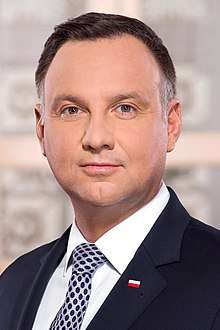
.jpg)
